#the last art takes.... so much context for what the director's DOES actually
Explore tagged Tumblr posts
Text



Hello, I have my little guy, a thirdfrin AU where Siffrin made a wish, but unlike Loop, wasn't as much of a guide. Loop calls him stardust, but he's more aptly named "The Director". Thus, Director AU.
An AU where Siffrin was convinced the loops would never end, that this was always going to be their life forever more, this too sweet existence grating until they feel like they're nothing, he makes another wish.
"I don't want to be here, I can't keep up acting like this, but please give me the power to keep going"
But The Director is not a guide. They are here to ensure that this Siffrin will endure.
Another Siffrin wakes up in the meadow, another try to end these cursed loops. Loop is not as fun of a guide, but they look at this new Siffrin, and calls him our satellite. Loop doesn't play any games, no laughing no fun, the break was lost when stardust decided to give up too. Besides, Loop learned their lesson in trying the same things over and over again and expecting different results. Loop tells them about the keys and refuses to let them leave rooms without taking the ones they would have missed otherwise, makes sure they always go the right directions, all of it.
Perhaps Loop is a good guide, but not much of a friend.
This Loop also doesn't talk with this Siffrin except for the bare minimum. "I'm here to guide you, satellite! Nothing more, nothing less! If you want to talk to someone about the loops, maybe you should talk to your party!"
Loop is a bit more insistent about this whole "tell your party about the loops" thing. Siffrin doesn't get it.
Loop lets Siffrin die to the King; they don't think Siffrin would have believed them if they said he needed a shield. But the dutiful guide tells them of a shield and a secret library. As Siffrin goes to get their needed tools, Loop tries to think of what they can do to make sure their satellite doesn't fall into despair like their stardust did. Because, despite stardust abandoning them, Loop fundamentally believes there is a way out. There HAS to be.
Why would they be here to help otherwise?
Siffrin defeats the King after a few tries. After victory Mirabelle runs ahead. Happily, he guides the rest of the party to the Head Housemaiden and to the end of their journey.
But there's a shout, Mirabelle runs back.
Something is blocking the way. A giant curtain of night as far as the eye can see stretches across the top of the house. There's also a welcome mat sitting oddly on the ground. Everyone tries to read it, but they only get a headache.
Suddenly, the curtain opens, a white glove beckons.
There are two choices, to take it or not.
Curiously, knowing they can just loop if something goes wrong, Siffrin takes it, much to the other's distress.
They're INSTANTLY pulled in. Beyond the curtain, there is nothing but an empty void and a face familiar to their own, but wrong wrong wrong. A star in their stomach, hair of stars, and an incomprehensible shade echoing out from their feet and hair. The being has no eyes to see, but Siffrin knows They Are Looking At Him.
"What are you?" Siffrin asks.
The being opens their mouth and reveals a full row of sharp teeth, made to tear apart and swallow. They speak, but Siffrin cannot hear the words.
The being closes their mouth. And opens it once more.
A single thought echoes and echoes in Siffrin's head.
[GO BACK]
Siffrin.
Loops.
Siffrin wakes up in the meadow.
[Memory of Control] When equipping this memory, your attack speed increases, but you will always do a random attack on your turn.
They immediately go to Loop. Good thing, because the star looks frantic. "I can't see anything past the King, satellite, but I know SOMETHING went down. Now explain."
Siffrin explains what's going on.
And by the end Loop looks on in horror, "oh stardust," they whisper, far too quiet, and almost said without their permission, "what have you done?"
And thus begins their mission to figure out what is going on with this "stardust".
#isat#art tag#luna draws#luna writes#isat spoilers#two hats spoilers#siffrin isat#director au#loop isat#the director#no idea their pronouns tbh tempted to go with 'any'#the director thinks they're helping!!! They are not!!!!#not sure when/if I'll write a fic of this but for now here they are#the last art takes.... so much context for what the director's DOES actually
21 notes
·
View notes
Note
What was it like meeting Val Kilmer? This is probably something that doesn't need asking but I've seen some more things about his bad reputation in the mid/late 90s and I'm just considering the word of someone who actually talked to him.
It was completely lovely. I've gone into a lot of detail about it in a previous post (it's in the last section), but basically it was the best possible experience. He set aside time to meet with me privately so we could have a real conversation one-on-one. He was warm and attentive; he asked me questions and listened when I spoke. When I explained to him how he and his movies had helped me, he seemed genuinely touched, and he thanked me. He gave me gifts, and insisted I get a picture of us together; I didn't even think to ask. I think I was probably literally glowing afterwards.
I've given thought to the rumors of his misbehavior during that period of his life. I'm definitely biased in his favor, but every complaint someone's made against him seems easily explainable given context. The directors of Top Secret! complained that Val asked them too many questions about his character, but this is Val's first major film role. He's the lead. He's only a few years out of Juilliard, which takes the same view of acting that Val did and does: That it's an art. He wants to do a good job; he asks the directors for direction, which is, like, literally their job that they get paid for? idk. Val butted heads with John Frankenheimer, the second director for The Island of Dr. Moreau (and the man who said, after Val wrapped, "Cut! Now get that bastard off my set!" so clearly Frankenheimer wasn't a big fan of Val's, either), but most of his concern seems to be about Frankenheimer not finishing the film. Val had just been informed of his impending divorce via entertainment news in a foreign country, and the first director of Moreau had already dropped out of the picture. Being anxious about partnerships ending and people leaving seems normal given the circumstances. I read a great anecdote from a teamster on The Doors, who had heard a rumor from other crew that Val insisted no one was to look him in the eye or speak to him because he was in character at all times. The teamster ignored this because he was a veteran and had heard his share of weird shit, and one day on set happened to start up a conversation with Val, during which Val asked him, "Hey, do you know why the crew in this city is so unfriendly?" He hadn't even heard the rumor, much less made the edict. And let's be real: It's in the interest of entertainment media to sensationalize things and blow them out of proportion. Drama makes for good TV.
TLDR: I don't worry about it too much. Every personal story I've heard from people I actually know and trust has belied the ugly rumors.
30 notes
·
View notes
Text
Geoffrey Hill – 'The Unconscious Mind's Intelligible Structure': A Debate
I have chosen as title for this brief and inconclusive debate a phrase from Richard Ellmann's Eminent Domain (1967, 52). It is there said of Yeats that to the end, even in his last poems where everything estimable is imperilled, he remained stubbornly loyal to the conscious mind's intelligible structure.' I think it proper to emphasize that I am taking the phrase out of context and employing it in a possibly-arbitrary fashion.
The debate begins, somewhat remotely, by attempting to distinguish between various kinds of objectivity, in the hope that the distinction may profitably be applied to a consideration of modern poetry, particularly that of Yeats. At the outset it is necessary to refer to three epigraphs or texts. The first is from Donald R. Pearce's introduction to his edition of The Senate Speeches of W.B. Yeats (1961):
Mrs Yeats once explained to me that [Yeats] was accustomed to distinguish those pages of manuscript that were to be discarded from those that were to be kept and filed by referring to the latter as 'history'; early drafts of certain poems, abandoned ideas for a play, alternative versions of some essay - all had their place in an intellectual and personal 'history that was as objective to his scrutiny as if it were not his own but the life of another man (p.22).
The second text is a phrase from an essay by Matthew Corrigan, in which he writes of the 'primary objective world... its cruelty and indifference (Encounter, July 1970, 85). The third citation is from Simone Weil:
Simultaneous composition on several planes at once is the law of artistic creation, and wherein, in fact, lies its difficulty. A poet, in the arrangement of words and the choice of each word, must simultaneously bear in mind matters on at least five or six different planes of composition. . .Politics, in their turn, form an art governed by composition. on a multiple plane. (The Need for Roots, translated by AF. Wills, 1952, 207)
One understands Simone Weil to be suggesting that poetry recognizes the primary objective world not so much by exercising its discursive faculty as by enacting a paradigm: a paradigm in which objective... scrutiny', in the Yeatsian sense, is put into the arena with Corrigan's 'primary objective world'. The value of her statement, from one's own point of view, is in her recognition that one does not attain objectivity simply by surrendering to the primary objective world. Corrigan, of course, sees this too. I am employing his phrase for its succinctness, not because I have any quarrel with it. One's debt to Simone Weil is precise. Within the circumference of her 'law', lyric poetry is necessarily dramatic: indeed, the 'different planes' actually available to a director on his theatre-stage could even be regarded as an indication of what takes place 'simultaneously' in the arena of the poem. When Yeats depicts his own search for a speech 'natural and dramatic' (Letters, ed. Wade, 1954, 583), 'simple and passionate' (ib, 668) he is far from advocating spontaneous lyricism. He is, even, in the second instance, possibly echoing Milton. An early use of the word 'passionate in Yeats's Letters is to be found in his reference, in May 1887, to T.M. Healy's 'rugged, passionate speech' in the House of Commons, 'the most human thing I heard. (35). It is arguable that Yeats's sense of 'simple and passionate speech was always forensic rather than domestic.
Yeats recognized himself, though not without irony, to be an artist in the nineteenth century Romantic tradition. This is a self-limiting truism which requires prompt qualification since, on investigation, no such simple entity as the Romantic tradition can be discovered. To make a distinction based on Yeats's own terminology in A Vision, one might suggest that Romanticism had (and has) both false and true masks. The false mask is formed from what Jacques Maritain admirably summarized as the two unnatural principles: the fecundity of money and the finality of the useful (Art and Scholasticism, translated by J.F. Scanlan, 1930, 37). The false mask either gleams amid the fecundity of money or utters, in terms of the finality of the useful, the wrong kind of moral answer. The London commercial theatre, at the turn of the century, flaunting the fecundity of money, aroused Yeats s contempt (Letters, 308–311). He was equally accurate in taking issue with George Bernard Shaw. As early as 1900 (Letters, 335) Yeats was calling Shaw 'reactionary', a particularly prophetic epithet in the light of Major Barbara. It is at least open to suggestion that Shaw's adherence to the finality of the useful, far from being antithetical to the false mask of Romanticism, is but a further manifestation of it. In paying lip-service to the realist, the practical man, Shaw makes the fecundity of money finally useful It is a synthesis of a kind, but such a synthesis as to mak Weil's 'composition on several planes' a preferable alternative.
Having sketched this view of the false mask one will rightly be required to present an image of the true mask. Thus, the 'true mask' could be shaped in one of two ways, each of which is in accord with the conscious mind's intelligible structure The first way presupposes a grammar of assent. The second w: is available if the first is not; and is the way of syntax. Synt: could be understood as Donald Davie presents it in his bor Articulate Energy (1955) or it could be extended to accomodate Simone Weil's 'law of artistic creation', as defined The Need for Roots.
In setting the phrase 'grammar of assent' in lower case ty one is arbitrarily making a metaphor, a metaphor to take place of Newman's reality. A Grammar of Assent is not same thing as a grammar of assent; and one's metaphor exists to acknowledge the difference
As the structure of the universe speaks to us of Him who made it, so the laws of the mind are the expression, not of mere constituted order, but of His will. (John Henry Cardinal Newman, An Essay in Aid of a Grammar of Assent, 1913 ed., 351)
The shape of my debate, if it can be said to have one, require 'mere constituted order' to be held in equal observation against 'the conscious mind's intelligible structure'. It will not have escaped notice that my discussion relies heavily on a law' devised by a writer who, in the words of E.W.F. Tomlin, devoted a good deal of 'wistful attention' to the Church but who was unable, finally, to assent. One is, with the greatest reverence and respect, citing Simone Weil's predicament as being an exemplary one. She has been dead nearly thirty years; the issues have long been public; one is not trespassing on any privacy. It needs to be said equally strongly that one is not trespassing on one's own privacy. There is nothing 'confessional' about this debate. The situation is far from being intimate. Arguably one is describing, albeit hypothetically, a common cultural predicament: so common as to verge on mere truism. One cannot, however, pervert the purity of Newman's meaning. A Grammar of Assent would have to be Catholic: 'Non in dialectica com-placuit Deo salvum facere populum suum'. A grammar of assent, which is a lesser thing, a metaphor, does not have to be Catholic, though it could be:
. . .when faith is informed by what Newman calls real assent, which involves the imagination, it is as living as the imagination itself', and this means to say that it not only leads on to action, but is enriched and deepened by action. (Alexander Dru, Peguy, 1956, 60)
Readers of Alexander Dru's book will recognize that my emphasis does not do his argument justice. I have chosen to interpret as metaphor a statement that he did not necessarily set down as metaphor; and for this I would ask his forgiveness.
It is my contention that there are certain sectors, not necessarily or exclusively Catholic, where real assent, involving a reciprocity between imagination and action, can be observed. There is a sense in which Conrad's assent to the code of the British Merchant Service provided him with a grammar that transfigured syntax as effectively as it transcended dangerous spontaneity. Óne thinks particularly of the two polemic essays, first published in the English Review in 1912, on the sinking of the 'Titanic. His imagination not only leads on' to action but is 'enriched and deepened' by his grasp of right action:
So, once more: continuous bulkheads — a clear way of escape to the deck out of each water-tight compartment. Nothing less. And it specialists, the precious specialists of the sort that builds 'unsinkable ships, tell you that it cannot be done, don't you believe them. It can be done, and they are quite clever enough to do it too. The objections they will raise, however disguised in the solemn mystery of technical phrases, will not be technical, but commercial. (Notes on Life and Letters, 1921, 314)
One notes here how facialties come together: the faculty of moral indignation with the faculty of practical amelioration. Contrasted with this, Arnold's 'sweetness and light' is inane and what Yeats called Burke's 'great melody sounds off-key, reveals itself to be, for all its resonance, a protest against natural right in the name of expediency'. (H.J. Laski, Political Thought in England: from Locke to Bentham, (1920), 1932, 187).
With Burke, however, we approach our second category. Failing a grammar of assent, syntax may serve. Possibly it is not untrue to say that the best answer to Burke's conservatism is to be found in his own pages.' (Laski, 176). In this respect Laski's suggestion conrelates with Arnold's praise of Burke's return... upon himself'. In his essay "The Function of Criticism at the Present Time', Arnold cites the concluding passage of Burke's 'Thoughts on French Affairs' of December 1791:
The evil is stated, in my opinion, as it exists. The remedy must be where power, wisdom and information, I hope, are more united with good intentions than they can be with me. I have done with this subject, I believe, for ever. It has given me many anxious moments for the two last years. If a great change is to be made in human affairs, the minds of men will be fitted to it; the general opinions and feelings will draw that way. Every fear, every hope will forward it; and then they who persist in op. posing this mighty current in human affairs, will appear rather to resist the decrees of Providence itself, than the mere designs of men. They will not be resolute and firm, but perverse and obstinate.
Burke's passage is plangent with futile simplistic determinism and witless platitude (the minds of men will be fitted to it... this mighty current in human affairs). If Burke were spontaneously ejecting platitudes it would be contemptible. It is his very recognition of the force of the contemptible, in oneself and in others, that makes the passage an arena of 'several planes. The fact that such a quality of recognition may be thought uncharacteristic of Burke's general mode does not invalidate its particular power or detract from the effectiveness of Arnold's choice. 'That return of Burke upon himself' says Arnold, has always seemed to me one of the finest things in English literature, or indeed in any literature.' At the moment that one recognizes the justice of Arnold's praise, one simultaneously seizes upon the nub of his situation. Burke's words, which have impinged upon Arnold's critical intelligence in their true nature, that is, as thwarted politics, are made to issue from Arnold's critical intelligence as a quite distinct entity, that is, as English literature'. If, as Alexander Dru suggests, assent in the illative sense 'not only leads on to action, but is enriched and deepened by action', , then Arnold, for all the fineness of his critical eye, is subjecting Burke's sentences to a process of negative conversion. How an intuitive sense of this can oppress a fine intelligence is, I think, nowhere better described than by Arnold himself, brooding over 'Empedocles on Etna':
What then are the situations, from the representation of which, though accurate, no poetical enjoyment can be derived? They are those in which the suffering finds no vent in action... in which there is everything to be endured, nothing to be done. (Preface to Poems, 1853)
If one cannot have a grammar of assent one has a dichotomy. On one side of this will be, at worst, a dependence on tones of voice, Arnold's fastidious whining about an original shortcoming in the more delicate spiritual perceptions'; at best, syntax or 'the conscious mind's intelligible structure. On the other side there may be merely 'manic and depressive phases of activity and inactivity, mostly of an 'intermittent character', as Conor Cruise O'Brien suggests in his essay on Yeats's politics:
If a Marxist, believing that history is going in a given direction, thinks it right to give it a good shove in the way it is going, it is natural enough that one who, like Yeats, feels that it is going in the opposite direction, should accompany it that way with, if not a shove, at least a cautious tilt. (O' Brien, in A.N. Jeffares and K.G.W. Cross, eds., In Excited Reverie, 1965, 263, 265, 278)
Though his phrasing here is callous and slovenly, the critic is not at fault. He knows perfectly well what he is about and his words mimic effectively the nature of Yeats's error: an error which we are to discern amid the shambles of phrases like 'natural enough' and 'if not a shove. In Yeats's poetry there is imagination; in Yeats's politics there is action; but the one does not enrich and deepen the other. There is no real assent; there is no illative sense, no grammar. In politics, therefore, Yeats's aristocratic bias does not save him from vulgarity; the 'aristocrat' is conned by a pseudo-aristocracy of the gutter.
If, however, we accept the dichotomy as a simple datum, we have the right, within the terms of such a proviso, to praise the persistent energy of Yeats's poetic syntax. Arguably, the entire melody of Easter 1916, a poem that Maud Gonne, dedicated to the finality of the useful, thought wholly inadequate to the occasion, is itself an articulation of the Burkean 'return'. So, perhaps, is the second stanza of section five of 'Vacillation', though here one's argument is less secure. Yeats's gesture strikes one as being formulistic:
Things said or done long years ago, Or things I did not do or say But thought that I might say or do, Weigh me down, and not a day But something is recalled, My conscience or my vanity appalled. (Collected Poems, 1950, 284)
The mannerism of lines two and three is close to being a travesty of what Arnold meant when he praised that return of Burke upon himself. Perhaps, though, the last-minute snatching away of the formula constitutes a more genuine 'return'. The last four words of the stanza redeem the truism. One could speak of 'conscience' with firmness and without appearing a fool. It is 'vanity' that, at the last moment, effects the 'return', that concedes the element of clownishness in the man who might have preferred to be a hero in remorse.
It is the final lines of 'The Second Coming that offer what is perhaps the finest of these returns. Scholars have made us familiar with the volatile emotional essences, what one might call the petty romanticism, out of which this major Romantic statement developed. We have learned of the possibly subconscious recollection of Shelley's 'Ozymandias' in Yeats's mental image of a desert and a black Titan' (see Jon Stallworthy, Between the Lines, 22-3) and we have read, in Yeats's own note in Wheels and Butterflies (1934 ed., 103) of a brazen winged beast' that he 'associated with laughing, ecstatic destruction'. I have called such recollections 'petty romanticism'. Yeats made his major discovery in the poem itself, ending:
And what rough beast, its hour come round at last, Slouches towards Bethlehem to be born? (C.P., 211)
As far as the original petty vision of laughing ecstatic destruct-ion' is here concerned, Yeats has revoked it, in the energy of imagination needed to recall it. He has returned upon himself and, as in the case of Burke, one would hazard the suggestion that the revocation is the outcome of acute historical intelligence drawing its energy from the struggle with that obtuseness which is the dark side of its own selfhood. In. Yeats's case, however, one does not refer so much to the conceptual intelligence operating through language-as-medium, as to the intelligence activated by the pitch of words. Jon Stallworthy has said (Between the Lines, 1963, 6) that 'where words are concerned [Yeats] has almost perfect pitch'. A poet who possesses such near-perfect pitch is able to sound out his own conceptual, discursive intelligence. The simultaneous bearing in mind described by Simone Weil would here relate to Stallworthy's suggestion about 'pitch. The poet is hearing words in depth and is therefore hearing, or sounding, history and morality in depth. It is as though the very recalcitrance of language - and we know that Yeats found the process of composition arduous - stood for the primary objective world in one of its forms of cruelty and indifference; but also for the cultivation of that other objectivity, won through toil (as objective to his scrutiny as if it were not his own but the life of another man').This is the most rewarding implication to be drawn from the exchange of letters between Yeats and Margot Ruddock. The debate between the old man and the young woman is emblematic, as when Yeats writes in reproof When your technic is sloppy your matter grows second-hand there is no difficulty to force you down under the surface _ difficulty is our plough." To this Margot Ruddock replies Do you know that you have made poetry, my solace and my joy, a bloody grind I hate! . . .poetry should not be worked at.' (R. McHugh, ed., Ah, Sweet Dancer, 1970, 81, 88). The irony is that both Yeats's reproof and Margot Ruddock's retort would have to be construed as belong. ing equally to the Romantic tradition, if such a simple entity did in fact exist. Rather they should each be recognized as an individual gyre within the so-called 'stream' of Romantic think-ing; each of necessity involved with the other and yet radically in conflict.
As I have already suggested in referring to Conor Cruise O'Brien's essay on Yeats's politics, it may sometimes be necessary to mimic a dilemma. At this point in the debate one must suggest, on the one hand, that sincerity is not enough, that creativity means cunning and artifice and that 'spontaneity' is an illusion. On the other hand one may have to concede that social empiricism has made of 'sincerity', especially in its current guise of spontaneous reaction to pressures, a potent arbiter of artistic motive and conduct. Put in its most extreme form, the sincerity of the primary objective world finds utterance in a book by the Polish writer Czeslaw Milosz:
The work of human thought should withstand the test of brutal, naked reality. If it cannot, it is worthless. Probably only those things are worth while which can preserve their validity in the eyes of a man threatened with instant death. A man is lying under machine-gun fire on a street in an embattled city. He looks at the pavement and sees a very amusing sight: the cobblestones are standing upright like the quills of a porcupine. The bullets hitting against their edges displace and tilt them. Such moments in the consciousness of a man judge all poets and philosophers. (The Captive Mind, translated by Jane Zielonko, 1953, 41).
Granted that this is a parable and not a manifesto; even so this passage moves from a first sentence of general acceptability to a third sentence that excludes from acceptability all those unbaptised by an arbitrary fire. The passage purports to establish new terms of the utmost purity: things and moments. What it does, in fact, is to elevate the man-of-the-moment. However humbled one may be by this, it is still necessary not to be bullied by its absolutist élitist tone. For those who detect the élitism, yet remain humiliated by their implied failure to live up to such demands, the poem of rigorous comfort is Yeats's'Easter 1916'. This poem could be described, in Simone Weil's terms, as a 'simultaneous review of several considerations of a very different nature (The Need for Roots, 206). It comprises middle-aged uncertain envy of those possessed by single-minded conviction, together with a humane scepticism about 'excess and romantic abstraction. One is moved by the artifice of the poem, the mastery of syntactical melody, that enacts this tension of 'several considerations'; the tune of a mind distrustful yet envious, mistrusting the abstraction, mistrusting its own mis-trust, drawn half-against its will into the chanting refrain that is both paean and threnos, yet, once drawn, committed utterly to the melody of the refrain. It is not Newman's real assent; it is not what I have chosen to call Arnold's negative conversion; it is certainly not Milosz's 'validity of moments in the con-sciousness. One can say only that it is a paradigm of the hard-won 'sanctity of the intellect (cf. Letters, 525). 'Intellect' is bound to be misunderstood but, in context, it should not be. One is in no way seeking to equate it with 'cerebral'. Yeats claims in A Vision (1962 re-issue, 268):
A civilisation is a struggle to keep self-control
but this poem, in its measure and syntax, stands as his more exact imagining of that struggle and that civility. One may well feel that Yeats presents arguments, or theories, that require to be answered. Yet even when this is so it remains true for him as for Burke: that the best answer is to be found in his own pages.
Published in Agenda, vol. 9/10 (Autumn–Winter 1971/2)
1 note
·
View note
Text
Alright, I'm going to attempt to hopefully clear up a few misconceptions and assuage some worries about this Disco Elysium sequel and the general situation at za/um right now.
I see the shitshow that is unfolding on social media, and as someone who has known about this whole disaster for over half a year now I'd like to weigh in on it and provide some context for everyone who may not know the full story.
First off, Robert Kurvitz was fired at the end of last year. December 2021. As is strongly implied on Martin Luiga's twitter, the reason for this is greed (calling them "money men" and "crooks" and other similar statements for like, months now), and the executive producers, Tõnis Haavel (who has previously been tried for fraud) and Kaur Kender (who has previously been tried for... other things.) screwed everyone over. Kender provided funding for the game, as the majority of the original za/um cultural association did not have the financial means to.
The original za/um cultural association consisted of Robert Kurvitz, Jüri Saks, Martin Luiga, and Aleksander Rostov, originally founded in in 2009. The group, along with Argo Tuulik, played many different ttrpg campaigns over the years, several of them set in Revachol (centred around Precinct 41), and slowly built the world up from there. Kurvitz released the book The Sacred and Terrible Air, set 20 years after Disco Elysium, back in 2013* but the novel flopped, and it was decided that they would make a video game. Rostov has always been more than just an artist for Disco Elysium, as you can see from the dev threads he frequently updated promoting the game, as well as on his personal instagram, tumblr sketch blog, and several other accounts he used while the game was first gaining traction.
*The most notable credits for TSaTA are as follows:
Author: Robert Kurvitz, Editor: Martin Luiga, Cover Design: Aleksander Rostov, Worldbuilding: Robert Kurvitz, Martin Luiga, Kaspar Kalvet, Argo Tuulik. Helen Hindpere and Kaur Kender also appear in the credits.
I say this because some of the staff at za/um are now accusing fans of being unable to overcome the "auteur theory" of it all (ie. seeing Kurvitz as the singular creative mind behind it all) but the fact is that they have now lost not only the original ttrpg campaign's game master, The Sacred and Terrible Air's author, and Disco Elysium's lead writer/director (Kurvitz) but also their lead writer for the Final Cut's political vision quests (Hindpere) as well as their "co-founder" and art director/designer (Rostov). They are all CREATIVE LEADS, and not just well known only for their reputations/titles.
Luiga himself (who originally broke the news) was an Elysium world builder and provided much of the pale and innocence-related lore. He was also a part of the original tabletop campaigns (Chester McLaine is his player character!), but left midway through Disco Elysium's development due to creative differences (or as he says, "bad vibes" at the company). He is credited as an editor, but claims to have written a good chunk of the text in the game, including much of Joyce's dialogue about the pale. I have seen people discredit him due to his early departure, but Rostov also tweeted out confirming that he, along with Hindpere and Kurvitz were no longer at the company, with no additional comments. Rostov also posted a drawing on his twitter several months back depicting a man jerking off over an NDA, so take that as you will.
So what does this mean for the future?
Luiga has said that he has hope for the sequel, which could either mean that the script was finished or nearing completion before Kurvitz was fired (likely, and fits a pattern in the industry) and it's just a matter of finishing the actual game development aspect, or it may be that he has hope for the original za/um creatives to be able to re-acquire the IP.
I think it's worth pointing out that the original pitch for "Disco Elysium" was actually "The Return", and Disco Elysium was meant to be the smaller-scale prequel to introduce players to the world. Considering that the team was planning on this sequel all along, I think it's possible that a large amount of the "original" game was written years ago, so it's not all that far fetched to believe that the basic outline may be finished, or even that a large portion of the script already exists. Keep in mind that there are a large number of writers for both Disco Elysium and The Final Cut, and it may still be possible to work with a base that the others provided. We have no idea how far into development the sequel may be. Of course, proceeding without three key members of the original team is kind of a kick in the balls, and imo really quite disgusting, especially with how long the company has been keeping their departures secret (dishonesty is not a good look lmao), but it may still be canon, true to the authors' vision, and genuinely a good game in the end.
Argo Tuulik, original Elysium world builder and part of the old ttrpg campaigns, as well as a main writer on Disco Elysium, is still working at za/um. Justin Keenan, former writer on The Final Cut who wrote the political vision quests alongside Helen Hindpere, still works at za/um (and has been promoted to lead writer, according to his LinkedIn), as does Kaspar Tamsalu, who painted several character portraits, (René and Gaston) and worked as a concept artist on the original game. Plenty of the original creatives still remain. The sequel could very well still be in good hands at the development level, even if the higher ups are "crooked".
So, in conclusion... If this game comes out and they still haven't worked things out with Kurvitz, Rostov and Hindpere? Honestly... fuckin' pirate it. But it is very likely it could still be a great game that plays out as it was meant to! All that being said, FUCK za/um as a company, don't support them through Atelier or their merch store. I wish everyone luck if they do attempt to get the IP back, and I sincerely hope this fan pressure will help get things moving for them.
#disco elysium#ada speaks#if anyone would like sources i can supply them#i just didnt want to bog down the post with links just in case it doesnt show in the tag#im leaving out a lot of shit for Reasons but i hate to see people upset because i do genuinely have hope for the future of elysium#but i will vouch for the quality of the sequel myself.#some minor updates as i accidentally stated argo was part of og za/um
3K notes
·
View notes
Note
Hello! I think I remember that you guys do voice acting. I was wondering if you have any tips for getting into voice acting, or any tips for someone who's POC specifically who wants to go that route? My friend has been thinking about doing so, and I've been trying to help her out with it so I thought to ask
Huh, ok, so I guess for context, we do this as a hobby! We really could have turned this into paid work (not by joining the big industy, but by charging for lines in general), but figuring out prices has been very weird for us- it's different from charging for art!
I'm going to talk about voice acting at home, not on set/at a studio. We're also more of a character voice actor, s if your friend is looking to go into advertising, narration, etc, our knowledge will be limited on that! But the general idea should be very similar if not the same for some things. (Some companies and businesses or paid work in general will let your record at home, etc.)
We're going to ramble, so I'll put this under a read-more
(Also, a lot of us actually contributed to this post over the last few days, so it’s possible we repeat a few things, or our first-pronouns keep changing. Hope it still makes sense!)
Under the read-more, we’ll talk Equipment, Getting started (Auditions), and Other random advice we threw in.
Equipment
Anyway, you first want to start with your equipment. In our opinion, what matters isn't the name of what you have- but the quality of your end product. If you're recording with an iPhone for example (which is said to have one of the clearest microphones for a phone), that's fine! We knew someone who recorded his lines using his headset microphone. There's this knowledge that headset microphones have really bad quality, and the brand he has is known for being very bad in our country: CDR King, but it was VERY VERY CLEAR.. I remember in voice calls, we'd be at awe with how crisp his voice was! If you're using what you have, just make sure you take care of your equipment- what matters is how it sounds in the end. I will say though, that what's more required of you should be good headphones or earphones, so you can hear what you sound like, you should be able to pick up any mistakes or your background noise (i applicable), the fuzz, etc..
We use Garageband, since it came free with our macbook. I’ve seen a lot of professionals use Adobe Audition. These are not requirements:
Get Audacity. As a voice actor, your job isn't to clean up your lines, but if you're working without professional equipment (AND even if you DO have professional equipment, get Audacity), this really helps with Noise Removal! It's free! You can look up "how to do noise removal in audacity" and there is a lot of information on how to use this thing. For every recording, we put it through Noise Removal in audacity, unless our director specifically tells us not to (we usually ask every director when we meet a new one).
Additionally, you can record in audacity, which is once again free! It makes voice acting so much more accessible to those that can only use what they have
But if you're here to look for microphone and equipment recommendations:
We haven't tried that many Microphones; we've only been voice acting since 2014, and have only had literally 2 microphones over the 8 years! We got our first microphone in maybe 2016, though? When we started taking things seriously, and got a replacement microphone in maybe 2019, which has been our current microphone ever since. I say this, because we might not be the best perspective to suggest microphones from! Stuff's expensive, haha.
Our first microphone was an AT2020 USB by Audio Technica.
In our opinion, it's a good starter microphone. It does it's job, but it's most for talking in our opinion. If you need to sing or scream, it might not be the best, but it did serve us alright. It was a USB microphone, which will not be as good as an XLR. We replaced it because its quality started to degrade (it couldn't handle us screaming). But, Like I said, if you take care of your equipment, everything can last you a long time. We know a fellow voice actor who owns an AT2020 USB right now, and his audio is crisp :-)
Our second microphone, our current one, is a B-2 Pro by Behringer!
We finally got a mic stand so if we start slapping our desk, it doesn't absorb our shock hahaha. The quality is much better, and it can handle us screaming and shouting without the audio clipping. It came with a pop filter that hugged the microphone, and we could switch between different microphone modes! For solo voice acting, you just need it set to taking in audio only from the front side.
Also, when looking for your microphone, I highly suggest doing some personal researches on what ranges microphones can pick up. Some microphones can not handle screaming, while others can. Some microphones are only for talking, some can include singing, some will better pick up lower registers, some can pick up higher voice betters, etc. It’s complicated, but it’s something we looked up because microphones are expensive. And we wanted to make it worth it!
The best microphones will always be XLR's, which means you'll need an audio mixer so you can actually plug it into your computer!
I have nothing to add here, finding the right audio mixer for you depends on your preferences: Do you want every dial possible, so you can adjust the different frequencies in real life and in real time, or are you alright with handling all that in post production (Audacity, garageband, etc.)? With that in mind, do you want a small mixer instead? That will take up less space, and is portable. The only thing you need to worry about is making sure it has a USB output so you can actually plug it into your computer.
The first and only mixer we've ever owned is currently a XENYX Q802 USB. It has a bunch of dials and allows us for more than one XLR plugged in- which we don't need hahaha. It does its job! We just have to replace our microphone wire because you can hear its age now.
Before the pandemic, we were able to try a friend's audio mixer, because we recorded singing for him, and his audio mixer made our recordings so CLEAR without noise removal, but we were using the same microphone. IT WAS CRAZY. It was a Focusrite Scarlet (If you forget the name, searching "scarlet audio mixer" helps. It's a very small thing, and we know two people who own it! Very worth it.
Stepping In To Voice Acting (Auditions)
Like with any acting gig- go to auditions! This may be physical, or online. On Youtube, Twitter, and Tumblr, searching "casting call" and "auditions", then filtering by most recent, should help you! If you like certain medias, you can also type in the name in the search bar. For a huge majority of our voice acting ‘career’. We found casting calls via Youtube.
Otherwise, I highly recommend Casting Call Club, and joining discord servers surrounding casting calls and voice acting :-) For a long time now, we’ve been using CCC and Youtube to look for casting calls, but with Discord now existing, there’s plenty of servers out there. And just the other day, we found a casting call on tumblr!
Other Stuff (We throw random advice)
After that, the rest is just taking care of your responsibilities as a voice actor. Be on time, and respond to messages!
Unfortunately, we can’t give advice on how to price your work, we don’t have enough experience on that. but as usual, don’t go below minimum wage unless you’re totally fine with that. This is a service work, so just like how physical actors will have varied prices, it depends on your reputation and experience.
Editing your audio is literally not supposed to be your priority, unless you want to do that and it’s something you’d prefer than have someone else edit. If anything, the most I would suggest any voice actor do, is noise removal; But you shouldn’t be adding your own reverbs and echo’s unless, once again, you’re alright with that. I say this, because a voice actor’s job is to come in with your lines, give good takes, and leave. Just because you’re able to record at home, doesn’t mean you should be doing literally all the other work for every single project. That’s your director’s problem, unless you offer it
Don’t record more than 3-5 takes per line or paragraph. It will give the editor a headache, and it’s useless if all 5 takes will sound the same, anyway. What we do, is that after we finish recording a whole session, we go to audacity for noise removal. While we do that, we also listen through the whole recording to remove any useless takes to keep things quick and precise. this is Extra work, but a personal choice so we can look more professional and to-the-point.
If you need to scream for the line, then scream! Whisper screaming does nothing. Voice acting is not just saying the lines just because; you still have to be in character.
It’s ok if you’re not friends with the director or other cast members. It’s never an obligation for you to hang out in the cast servers. if you feel like you’re being forced to participate in a project server, that’s personally a red flag. You are allowed to say no to roles or events, this is especially if you are doing this as a hobby, or for free.
Voice acting needs you to be unafraid to be silly and goofy. Even if you’re introverted outside of the booth, you need to be able to show as much emotion with your voice when called for it! Allowing yourself to let loose means you can act for almost any role.
Speaking of the above, find out what you can do, and run with it. While we do original voices for characters of original works or creations, we actually started out with doing impressions of MLP Characters. To shorten the story, we’ve always wanted to play Fluttershy roles growing up, but the Fluttershy role is honestly oversaturated with voice actors who aren’t always the most accurate. Turns out, we’re extremely good at Twilight Sparkle, but originally never wanted to voice her. Thing is, No one ever voices Twilight Sparkle, it’s surprisingly in-demand since no one can do her much. Obabscribbler described us recently as one of the best Twilights out there. Even right up there with IMShadow :-). If you find your niche, it’s ok to run with it, even if you never originally planned to do that. Maybe something you never liked originally doing, was something plenty of other people of needed.
But if you feel stuck, practicing outside of your comfort zone will always be the best recommendation.
Lastly, take care of your voice! If you feel a sore throat coming on or a cold, immediately get as much rest. Your voice box is your tool, and you will be out of commission literally until you fully recover.
Also, I just realized that we didn’t include any advice for POC.. We’re Asian (Filipino), and I unfortunately don’t have a lot to add. I suppose this is because as a voice actor, you’re behind a curtain so no one will see you or your skin and features. I will say though- you can make it as a voice actor no matter who you are or what you look. As long as you’re a decent person, you can go anywhere and do anything. What matters, as a voice actor, is your skill. I say this as someone who voice acts at home, and does not go to physical auditions where people can see my face.
Your luck may especially come from those who are specifically looking for voice actors of color. If you want, looking for characters that have your ethnicity or accent might be something you’d be interested in! We personally just go after characters we want to voice, and it’s just a bonus if our ethnicity and background might match the character :-) (See: we voice a lot of non-humans haha). After all, you are supposed to be the character, unless the character was specifically molded after you. The different voice acting communities we’ve been in have been extremely diverse! The world is truly your oyster
9 notes
·
View notes
Text
Film Details #1: The Stairs in The Red Shoes
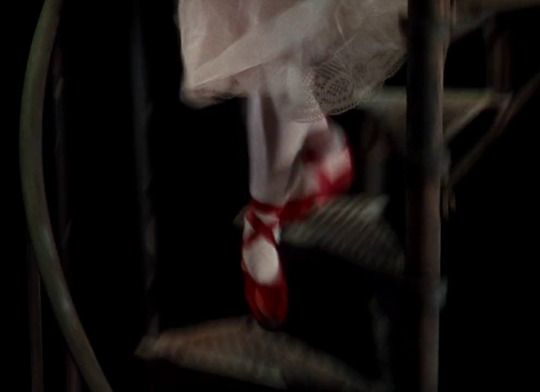
Film Details is a blog series of posts focusing on a specific detail in a film. Details may vary from a single shot, a particular cut, or a piece of sound to individual scenes, objects, and other elements in mise-en-scène as well as larger-scale motifs in the film under scrutiny.
One of the most memorable shots of The Red Shoes (1948), a mesmerizing classic of fable and ballet cinema, is actually a subtle combination of two identical shots by means of an almost unnoticeable jump cut. It is the image of Moira Shearer’s legs as she is rapidly running down a narrow spiral staircase. The shots are in a fairly small scale and framed in a manner that crops the rest of the character’s body so that attention is distinctly placed on the radiant red shoes on Shearer’s feet. Yet the background, or not just a simple backdrop of course but a space in which this event occurs, is also important: the staircase. Director Michael Powell has explained how he achieved the trick together with his crew. In order to capture the quickly moving legs of the actress, they had to first commission a separate spiral staircase to be moved and filmed, then make a rotating mount underneath the staircase so that they were able to move the spiral staircase in synchronization with the downward movement of the camera on the crane without losing the actress behind the edges of the staircase [1]. The impression is impeccable and alluring. There is an enigmatic sense of movement that feels impossible in a way that strangely resembles the viewing experience of a similarly enchanting, though very different, trick shot of a staircase in Hitchcock’s Vertigo (1958). What should draw specific attention to the staircase at this crucial moment in The Red Shoes, however, is that this is not the first instance of the in-between space of transition in the film. There are plenty of steps along the way.
Before compiling, analyzing, and interpreting the many stairs of The Red Shoes, it is important to provide a short reminder of the film’s basic story line. It is crucial to bear this in mind because it is the story and the characters’ core relationships that introduce the film’s key theme that is articulated and structured by the staircase motif.
The Red Shoes is a film about the conflicts of life and art. It tells the story of a young aspiring dancer Vicky Page, played by Shearer, who is hired by Boris Lermontov, played by Anton Walbrook, to his renowned ballet company. During the time that Vicky is hired, Lermontov also employs an up-and-coming composer named Julian Craster, played by Marius Goring. Together they achieve great success, both creatively and financially, when Lermontov produces a ballet based on Hans Christian Andersen’s fairy-tale The Red Shoes, starring Vicky and with music composed by Julian. To much of Lermontov’s disappointment, however, since he sees other matters besides art as destructive to the creative enterprise, Julian and Vicky end up falling in love. Lermontov fires both of them in hopes that Vicky would leave romantic love behind and come back to the lure of the red shoes and ballet, as she eventually does. Yet, Vicky remains torn between the two men, who represent her conflicting desires for love and art, and in the end dies by falling under a train. She is, just like the protagonist in Andersen’s fairy-tale, unable to take off her red shoes; she is incapable of shaking off her pernicious passion for art. The story is rather simple, but it is elevated by a cleverly treated intertext of the Andersen story. The theme is as old as mankind, but Michael Powell and Emeric Pressburger craft a unique cinematic discourse to articulate the theme and give it new meaning. Even more so, the film is rife with details that have this very effect. The staircase motif is one of them.
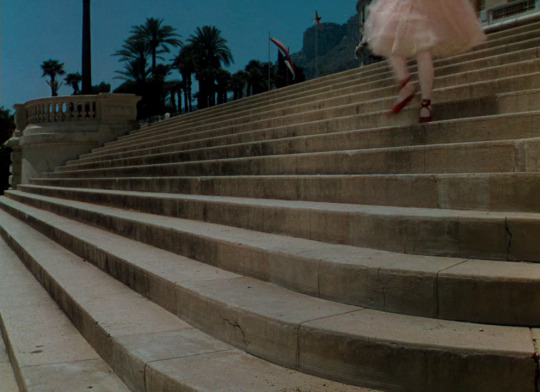
There is a plethora of stairs in the film. There are the stairs on the balcony to which Vicky runs and from which she falls to her death after leaving the rapid plunge to the spiral staircase behind. These steps on the balcony (and not the spiral staircase) are in fact the real last stairs of the film. More towards the beginning of the film, there are also the almost off-screen stairs leading to the party held by Vicky’s aunt in hopes of attracting Lermontov’s interest in her niece who is an aspiring dancer. There are the behind-the-scenes stairs leading to the stage at Covent Garden where Julian goes to after Lermontov has hired him for Ballet Lermontov. There are the further steps Julian climbs with Irina Boronskaja, the leading dancer of Ballet Lermontov who eventually leaves the company due to her marriage (exemplifying what Lermontov fears for Vicky). There are the stairs behind the stage which the dancers, including Vicky, walk down after the first class is dismissed. More towards the end, there is an underground staircase which leads to a platform at a railway station which Lermontov climbs to reach his train only to discover Vicky trying to convince him that there is room for more in her life than just dancing.
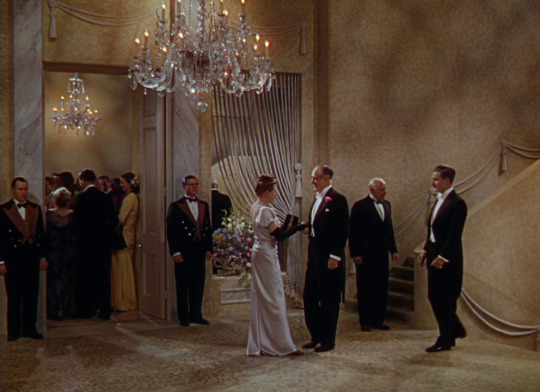
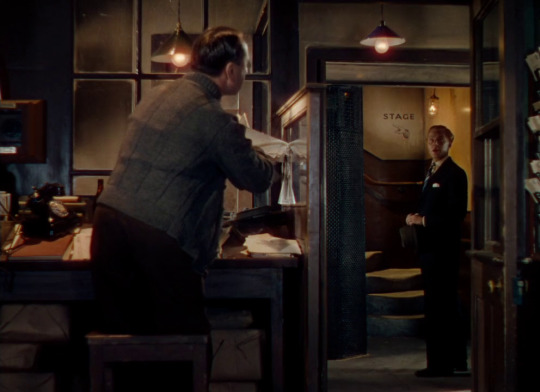
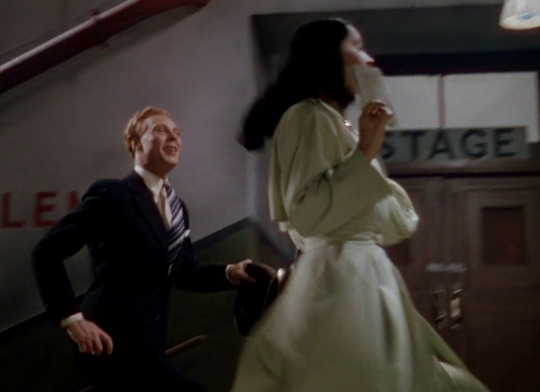
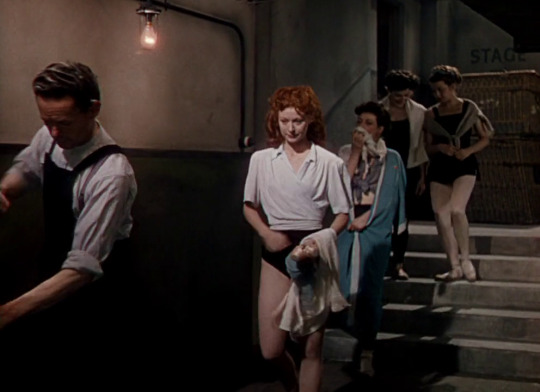
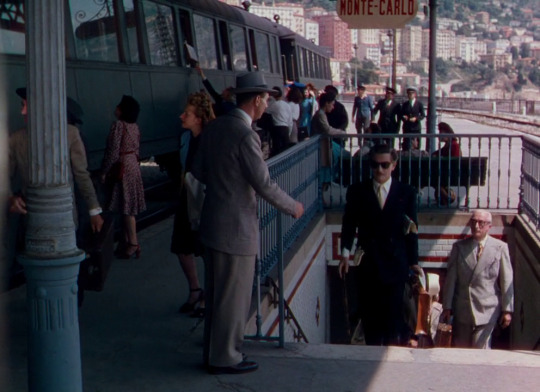
All these scenes concern, more or less explicitly, a movement between the outside world of real life and the dream world of art. I shall flesh out this interpretation in more detail below. It is perhaps more direct in scenes where characters move through stairs to the stage or away from the stage and it is perhaps less explicit in scenes such as Lermontov’s arrival to Vicky’s aunt’s party or his arrival to the train platform. But it is there, nonetheless: Lermontov’s confident walk on the stairs precedes Vicky’s attempt to reconcile the conflict; she tries to make Lermontov agree to let her dance as well as live her love life.
However, one scene not mentioned above is especially characteristic of this thematic function of the staircase motif. During the first day that Vicky and Julian are working for Ballet Lermontov, Lermontov climbs the small stairs of the theater from the auditorium to the stage. This moment, though seemingly minute especially when considered in the context of the staircase motif, is revealing in terms of the thematic function of the stairs in the film. In the long take, Lermontov first passes Julian trying to reach him in the auditorium and then Vicky trying to contact him on the stage. Lermontov moves from the shadows, that is, the real world, to the limelight of the stage, the dream world of art. It is this movement between these two worlds that is reflected by the many stairs of The Red Shoes.
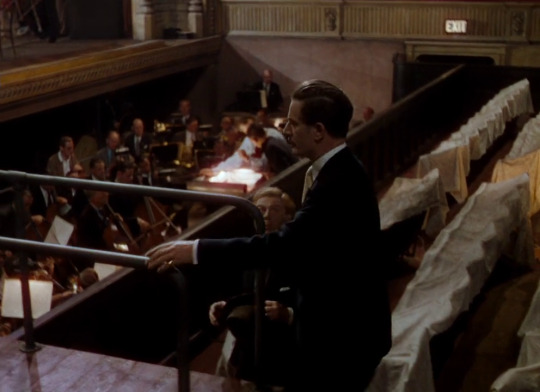
All the stairs mentioned above are quite minor. That is to say, one does not really pay attention to them unless one is specifically looking for them. Even the thematic function just outlined might seem a little vague at first. But it becomes more salient, I believe, when one looks at these instances in the broader context of the staircase motif with its most important manifestation. To be more specific, there are three scenes in The Red Shoes in which stairs gain increased significance: there are the entrance stairs of Covent Garden in the beginning, the stairs of a castle-like building in the middle, and the stairs in the end (the spiral staircase and the stairs on the balcony). Since I have already described the final scene with the spiral staircase and the stairs on the balcony, I will start by describing the beginning and middle scenes both of which have not been mentioned above.
The stairs in the beginning are actually the first thing that are seen in the film. The film begins with a low-angle shot of a staircase leading up. Off-screen noise of a crowd from the outside is heard on the soundtrack. A porter enters the screen space at the top of the stairs and walks down a few steps. A cut reveals two guards holding the door shut below the staircase. The porter tells them to open the doors and let the awaiting crowd in. The crowd is a group of excited students about to lose it over ballet. It is opening night for Ballet Lermontov at Covent Garden. The camera follows the intense running of the students through the stairs until it settles on a corner to capture their enthusiastic movement -- which even ends up tearing a Ballet Lermontov poster for the show on the wall. The real world that is left behind is tactile, palpable, whereas the world of art is anything but. The audience is there to sit still; they are there to see and to hear, as they very clearly emphasize in dialogue with each other. It is this opening scene that establishes the theme of movement between the two worlds through the staircase motif.

Between the scene with the stairs in the beginning and the scene with the stairs in the end (both the spiral staircase and the stairs on the balcony), there is appropriately another chief scene involving stairs in the middle of the film. It is the scene where Vicky, all dressed up in a beautiful blue dress with an adorable tiara, accentuating her red hair in glorious Technicolor, is summoned by Lermontov to attend his company in an eerie castle-like building straight from the pages of a fairy-tale. Arriving to the scene, she climbs a stairway only to find a massive set of steps covered in grass. At the top, there are more stairs to be climbed. And what awaits her after all these steps? Lermontov telling her that she will be cast in the lead role for his new ballet based on Hans Christian Andersen’s fairy-tale The Red Shoes. The length of passage from the ground to the higher top where Lermontov awaits seems to reflect the hardship that entrance to the life of art takes. At the same time, however, the duration of the journey to the top expresses the detachment of the world of art from the real world below. Furthermore, the long stairway covered in grass has a mystery to it, enhancing the transition to the dream world of art. It is as if the film took a momentary pause to emphasize not only the narrative importance of this turning point but also the enchantment of art, which is both alluring and horrific.
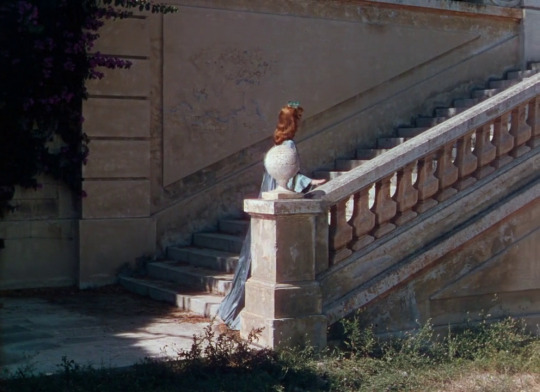
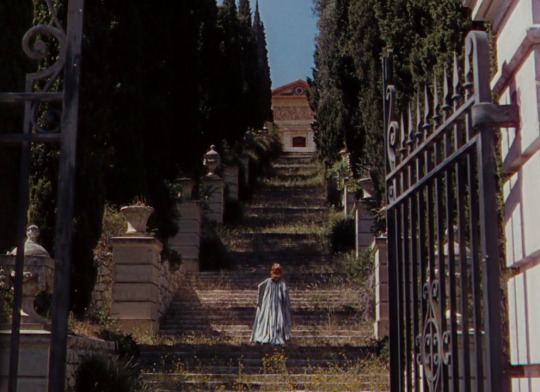
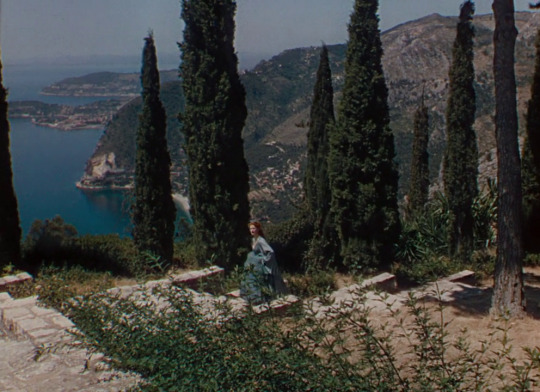
As said, the stairs in these three scenes are more noticeable. They articulate, perhaps more explicitly, the theme of movement between the real world and the dream world of art. In the opening scene, excited students rush the stairs, leaving the tactile real world behind, to get closer to the dream. Julian Craster, the composer who Lermontov eventually hires for his company and with whom Vicky ends up falling in love, sits on the balcony, listening to the music. Vicky, however, is closer to the stage; she is already enamored, perhaps too enamored, with the dream world of art. She is the one to tell Lermontov that the way others justify continuing to live is how she justifies dancing. To her, the raison d’être for human existence is equivalent with the raison d’être for dancing. And, of course, she is the one who ends up dying for it. In the scene mentioned just above, the scene where Vicky walks up the high stairs of the castle-like building to hear Lermontov’s life-changing announcement, there is a similar sense of inter-world movement. Vicky is dressed as a princess, not for this occasion that has come as a surprise to her; she climbs the stairs covered in grass to a castle; she learns that she will be starring in a ballet based on a fable. The fairy-tale connotation could not be more unambiguous. The real world is left behind as the character is elevated (also concretely via the long stairs) to a spiritual plane of art. The fairy-tale aesthetics are used to further highlight the detachment of the world of art from the real world, a detachment that is, as said, both seductive and frightening.
In both of these scenes, characters move closer to the realm of art. In contrast to them, the famous image of Vicky rapidly running down the spiral staircase conveys an opposite kind of movement. This is not just to point to the simple fact that people are running or walking up in the first beginning and middle scenes, whereas Vicky is running down in the last scene, but to make a metaphorical observation about these kinds of movement. In a word, Vicky’s rapid run is her fleeing the dream (her dream) rather than getting closer to it. Following the scene where she is practically torn apart by Lermontov and Julian, the former embodying the dream world of art and the latter the real world with romantic relationships, Vicky is struck by a feeling of horror as she wobbles toward the stage escorted by her dresser. She -- perhaps controlled by the red shoes like the girl in the Andersen story -- starts to withdraw. She rushes away and storms to the spiral staircase. The image of her legs racing the stairs represents her fear, her uncontrollable need, and her conflicted desire to get farther away from the dream world of art that means everything to her, but also, in the same breath, her conflicted desire not to leave the art world that has started to consume her. The ambiguity of what is in fact happening in this finale (is it Vicky’s own free will or the spell of the red shoes? Is Vicky running away back to her love or is she running to her death?) emphasizes the unresolved conflict of art and life that torments the protagonist.
What is striking about the spiral staircase in contrast to the other stairs in the film is its surreal dimension. When one sees stairs in the film, one is quite sure of their location and spatial relation to the other spaces. This is not surprising at all because stairs are precisely a connection link between two or more spaces, typically between floors. There can be clear visual cues such as an arrow sign and the word “stage” on the wall reminding us where the stairs are leading or cuts from previous scenes to subsequent scenes that provide spatial context for the stairs. Such is the case, for example, with the scene where Vicky is training with the other dancers of the company. The scene ends with the choreographer shouting “class dismissed!” A cut shifts us to the behind-the-stage stairs which Vicky climbs down (see the image above). One can see the word “stage” on the wall in the background. The camera follows Vicky as she moves farther away from the stage until the camera stops at the music rehearsal room where the next cut shifts us. For another example, take the scene with the castle-like building. A cab driver picks Vicky up from the hotel. A long drive takes her to an unknown destination, but shots of the beautiful natural environment give the spectator a spatially coherent sense of the journey. After the drive, Vicky is then seen at the beginning of the first stairway which she starts climbing; next, a cut to movement shifts us to her arriving to the top of these stairs where she opens a gate, in a mobile following shot, to the huge flight of stairs covered in grass. Finally, a dissolve shows her arriving to the top of yet another staircase, which eventually leads her to Lermontov. In both scenes, the spatial relations are very clear. No such cues are available for the image of the spiral staircase.
After the shot of Vicky running away in fear, there is a cut to the conductor of the orchestra starting The Red Shoes ballet. The next cuts shifts us to the spiral staircase whose exact location in the building remains a mystery. The following cut does not help provide context for the spatial relations either: the camera remains on Vicky’s legs in the red shoes, with the rest of her body cropped off, walking an unknown hallway and climbing down a few steps until she arrives to the stairs on the balcony which lead to the more familiar space of the balcony over the railway tracks. In addition to the shots preceding and following the two combined shots of the spiral staircase, the shots of the spiral staircase themselves further enhance the spatial ambiguity. Given the velocity of Vicky’s flee and the duration of the two shots, one would assume that the spiral staircase covered quite a long journey. It is hard to see where exactly in the building such a large spiral staircase would be located. It is possible, of course, but it is not clear by any means. It is a surprise to the spectator, and that surprise is precisely the point.
More important than the shots surrounding the image of the run in the spiral staircase is, of course, the overall uncanny impression of the image of the spiral staircase itself. By combining the fast movement of the actress with the synchronized movement of the camera as well as the unnoticeable movement of the spiral staircase, the image gains a totally unique sensation that is quite difficult to be put into words. The fact that the actual staircase in the physical space (of the studio setting) has been moved with the help of a rotating mount while filming enables the camera to capture the actress’ movement in a different way than it would had the staircase remained still. However, since the staircase does not move in the diegetic space (i.e., the space of the fictional world where the characters act), the visual impression is perplexing to say the least. This only highlights the surprise factor of the cut to the spiral staircase. The surrealism of the image emphasizes that the protagonist’s flee is not really physical or concrete but metaphorical. In the poetic space of the film, the character is detaching from the dream world of art that means everything to her -- from the world whose detachment from reality had been established at the latest with the fable-like stairs covered in grass. The unresolved conflict can only end in death.
In addition to the thematic trajectory outlined by these three scenes (first steps toward the world of art at Covent Garden in the beginning, then entrance to that world via the stairs covered in grass in the middle, and finally an escape from its consumption of the soul in the spiral staircase in the end), it is worth noting that the famous seventeen minute ballet sequence of the film also features stairs. That is, stairs are involved significantly in the production design of not only Powell and Pressburger’s The Red Shoes but also in The Red Shoes by Ballet Lermontov. There is a staircase in the background of the main milieu of the ballet, which is first being walked up and down by two women. In the end, the girl with the red shoes, played by Vicky, collapses on the stairs after being exhausted by the red shoes. Having been released from the curse of the red shoes by death, Vicky’s body is finally being carried by a man toward the stairs.
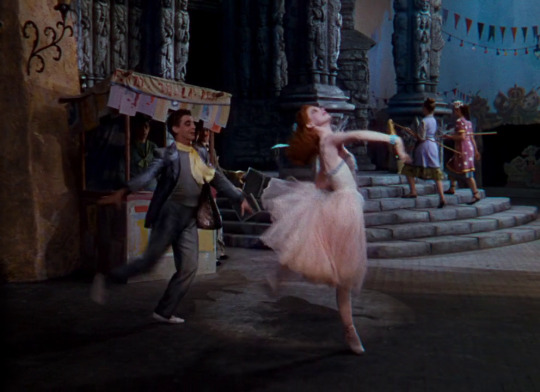
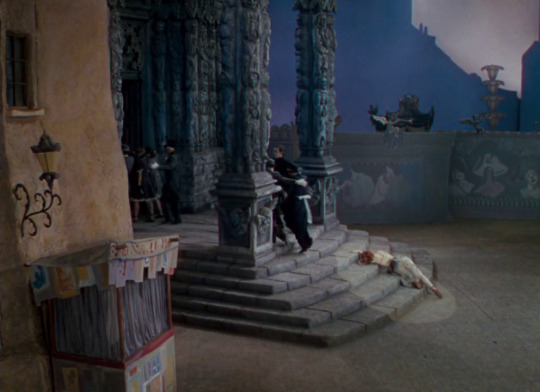
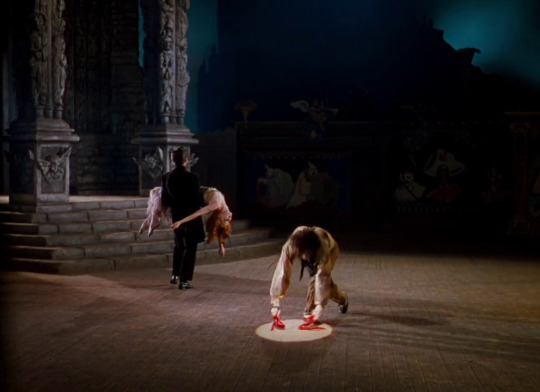
Although these uses of the staircase motif take place in a story within the story (the Andersen story as a ballet performed by characters in the film), it is quite interesting that stairs appear in the beginning and the end of the ballet, just as in the film itself. Stairs in the ballet also connote transition and, specifically, death. It is as if the stairs, which in the first instance are associated with entrance and movement, eventually turned into a gateway between two worlds. Vicky is first brought to the world of art (the first instance of the stairs in the ballet), then dies for it, and is finally being taken away from it back to reality (the last instance of the stairs in the ballet). This affinity between the ballet and the film should not come as a surprise, of course. For the ballet, to a very large extent, reflects many of the events in the film, including Vicky’s budding conflict between Julian and Lermontov.
The staircase is an in-between space between spaces. Movement in the staircase thus usually connotes transition. Here, I have claimed that the stairs in The Red Shoes operate as a metaphor for the characters’ (mainly Vicky’s) movement between the real world of life and the dream world of art. The movement is oftentimes casual, but even then it exemplifies this thematic function. In scenes where the movement is less casual and the staircase is more salient, that is, the three scenes in the beginning, middle, and end discussed above, the articulation and structuring of this theme is more conspicuous. Vicky is first pulled toward the dream world of art by its mysterious lure in the first and second of these scenes, which establish the detachment of the dream world of art from reality, but in the end she is almost pushed away from the dream world by its even horrific enchantment with which she once identified so strongly. In the astonishing shots of the spiral staircase, the link between the worlds has broken down, which is reflected by the eerie movement in the shots and the ambiguity of the relations to other spaces. The image is a shock. The extraordinary effect of the image of the run through the spiral staircase, a spatial link both displaced and uncanny, expresses this ambiguous and unresolved conflict of art and life in the life of an artist.
Notes:
[1] Michael Powell tells this anecdote to Peter von Bagh at the Midnight Sun Film Festival in 1987: “At the end of the film, when the girl runs to her death in the red shoes, she gets out from her dressing room. I thought that it would be terribly boring if she just ran the stairs down in an ordinary way so I had a spiral staircase of roughly six meters made for the scene, the likes of which are used in industrial facilities. I asked Moira if she could run down the stairs in her ballet shoes. She told me she could. The camera had to shoot the running from a descending crane. I asked Moira to run as fast as she could because I wanted the shot to be as short as possible. I gave Moira the signal to go, and she ran the stairs down faster than the camera was able to follow. She beat the camera by roughly 20 film frames. The cinematographers were ashamed. She had to run again, and this time the camera kept up with her, but when Moira ran the spiral staircase, she was of course momentarily concealed by the staircase for every lap. Since the camera was unable to turn around the staircase in the same speed, we had to have a rotating mount made for the staircase whose speed could be controlled so that Moira was constantly kept in front of the camera. We told Moira that now she could run as fast as she wanted. She ran and won the camera again by two seconds. Later, once we had the shot, my editor Reggie Mills asked me if we could lengthen the stairs. I answered no, unless we would get a new staircase. But the shot was too short as it was so we decided to develop it twice and then cut the pieces together so that it would look like one shot.” (Peter von Bagh, Sodankylä ikuisesti [Sodankylä Forever], WSOY, 2010, p. 55; my translation from the Finnish text.)
22 notes
·
View notes
Text
Monster Hunter Rating 21: Khezu, the Blank Stare
When I reviewed Basarios, I made a joke about how the devs likely gave it human teeth over sharp teeth because the latter might not give children nightmares, but I don’t actually think that the devs ever intended Basarios to be more terrifying than any other monster in the game. This monster, however, is literally the stuff of nightmares, and I’m not misusing “literally” here. This may be the longest review I’ve written yet, so buckle up. Time to get spooky with Khezu!
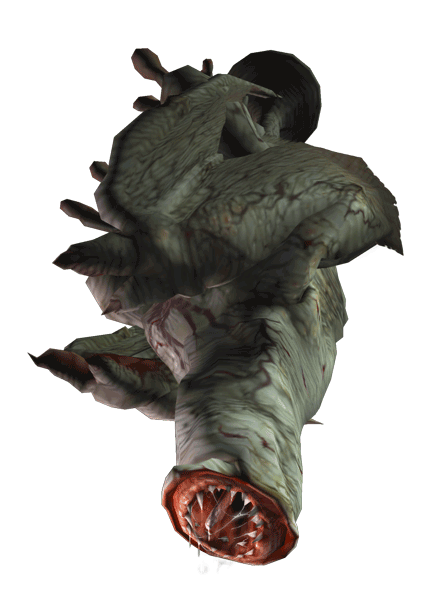
(How it appears in Monster Hunter 1)

(How it appears in Monster Hunter Rise)
Appearance: I think there’s been a mistake here; last I checked, Capcom wasn’t making Silent Hill games. Seriously, this thing would fit right into that series, and not just ‘cause its phallic neck lends itself well to metaphors. The pale, veiny skin, the leech-like mouth, the complete lack of eyes...Khezu’s unlike any other monster in the series because it’s the only monster that’s meant to be horrifying to look at. It’s got flabby, tattered wings and gecko-like feet, but its main characteristic (other than the head) is its tail, the tip of which can open up into a suction cup that allows Khezu to stick to ceilings.
Obviously, Khezu’s an abomination that came from a really dark place in someone’s mind, but that’s just it: Khezu is a monster that appeared in an MH developer’s nightmare either before or during the production of the first Monster Hunter game, and said developer (I don’t actually remember who) decided to put it in the game. I learned of this from the Twitch streams of a streamer called DuncanCan’tDie, who’s a huge MH fan that’s on great terms with Capcom. Unfortunately, I can’t find any other sources for this claim, but I don’t think he’s lying for a few reasons; firstly, like I said, he’s on great terms with Capcom. He’s friends with some people who work there, and he even has a tattoo designed by someone on the MH team he called “Kaname-san” (who didn’t actually give him the tattoo, but drew the design that a tattoo artist used) and the only person who could go by that name is Kaname Fujioka, the man who literally directed several MH games, including the first one, and who was the art director for Monster Hunter World. So yeah. Duncan and Capcom get along great, and if he was spreading false rumors, they’d probably know about it.
The second reason I believe Duncan about Khezu’s origin is that someone once came into one of his streams (and I was there at the time) and started spouting “lore” about two monsters that looked like they could be related, but actually weren’t. Duncan flat out told this person that what they were claiming wasn’t mentioned anywhere and asked for sources...which the loregiver did not provide. In fact, after Duncan started getting on their case, I don’t think they said a word for the rest of the stream. Duncan believes that this person was just making stuff up to sound like they knew a lot about MH and weren’t aware that he was an MH expert, and I doubt that someone who would call someone out on that would do the same thing, especially if he had a reputation to uphold.
I apologize if I spent a lot of time talking about that, but I didn’t want people getting on my case because they couldn’t find anything to support my claims. But in conclusion, I believe that Khezu truly was born of a nightmare, and that’s awesome. It makes the Silent Hill comparison even more fitting since the enemies in those games are basically projections of the protagonists’ psyches. Disturbing enemies are much more effective if they scare(d) the people who created them, and Khezu is certainly disturbing. Because of that, as well as its ominous origin, I’m giving it a 9/10.
Behavior: Khezu mostly inhabit caves, jungles, and swamps due to the need for their skin to be moisturized, though they usually only leave caves to hunt, which they don’t have to do very often due to the plentiful fat beneath their skin, which also keeps them warm. Their favorite hunting strategy is to ambush their prey from a location usually concealed by darkness, which is made easier by their extendable necks. However, their reliance on darkness, as well as their preference to dwell in caves, has made them completely blind and reliant on their other senses; despite not having visible nostrils or ears, Khezu have great hearing and a very good sense of smell. Back to hunting, while they need to subdue larger prey, smaller ones, like Kelbi, are slowly swallowed whole...which is apparently something you can actually witness in the games, according to TV Tropes (I normally stick to the wiki and what I already know for resources, but I went to the “Monster Hunter / Nightmare Fuel” page while searching for another source for Khezu’s origin as a nightmare). As if this thing needed to be more disturbing, it doesn’t always kill its prey before it tries to swallow it, so the Kelbi you can see it eat is constantly struggling as the Khezu swallows it bottom-first. That’s...that’s messed up. But it gets worse.
Practically every monster in this series isn’t any more intelligent than what we consider a normal animal to be. Aside from Lynians, which are people, the smartest monster I’ve talked about is the Velociprey, which might not be as smart as, say, an irl crow, which is very intelligent by the standards of nonhuman animals. What I’m getting at here is that most of the monsters in this series don’t really take any sadistic pleasure in killing and eating prey; they just do it to survive. But Khezu is different. In several MH games, including Rise, the first time you go on a quest to kill a specific monster, the gameplay is preceded by a cutscene that shows off how powerful or intimidating that monster is (and in Rise’s case, you also get a poem). Here’s Khezu’s intro, and I want you to pay attention to what Khezu does from 0:24-0:30:
youtube
That’s right: this thing��“looked” right at the monster it was going to eat, and smiled. That isn’t just me anthropomorphizing it, either; I’ve seen what Khezu looks like outside of that cutscene, and even with its mouth closed it has a neutral expression, so it smiling actually means something, and considering the context, it’s obvious what the devs wanted us to take from it: Khezu likes killing. It enjoyed the prospect of swallowing that monster whole while it was still alive and struggling, which means that this is the first monster I’ve talked about that we can definitively say is evil rather than just an animal. Rather fitting for a living nightmare, I would say. And if you thought all that was disturbing, I have some...unfortunate news. I hope you aren’t eating anything right now, ‘cause this next part is just gross.
Y’know how some wasps lay their eggs inside other bugs so the eggs have incubation they can eat when they hatch? Well, uh...Khezu do that, too. And they’re hermaphrodites that, from what I can gather, don’t need to mate, so any adult Khezu is capable of injecting another monster with its “whelps” (not saying that Khezu are always “pregnant,” just saying that any of them can be). And you know the really crazy part? After everything I said about Khezu, there are still people in the MH world that tame them and keep them as pets. Why would you want to have a slimy, flabby, sadistic, parasitoid, 14-to-40-foot abomination as a pet!? God, people are so freaking weird.
EDIT (05/07/2021): My older brother reminded me that I forgot about one of the odder aspects of Khezu; when you enter a fight with a Main Monster, its battle theme plays (don’t know if every monster has a unique theme, but several do, to my knowledge), but Khezu has no theme to speak of. I don’t know if this is true in every game, or even if it was intentional at first, but it’s still both funny and eerie at the same time. There’s no background music until you get in a fight, so if you somehow tick off a Khezu without seeing it, then it can sneak up on you. “But Zaph, the moment a monster enters ‘fight mode,’ it roars! So the Khezu will give away its position!” See, you’d be right about that if it wasn’t for the fact that, according to TV Tropes at least, Khezu’s roar sounds just like wind--howling wind, yes, but wind all the same. I don’t know if there’s any howling wind SFX in the areas where Khezu live, so for all I know you’ll still be able to identify it in a hurry, but just imagine what that’s like in-universe! Imagine that you’re walking around in the Frost Islands or something and hear a chilling wind from out of nowhere. Unless you’re an experienced hunter, you’d likely have no idea if that was a Khezu or not, so you wouldn’t know if it’s too late to run or not, or even if you should run at all. Going back out of universe, the details I just described are very nice touches to a monster that was already horrifying in behavior, so I’m bumping the score here up from the 7 I initially gave it to 8/10.
Abilities: All of the “Flying Wyverns” I’ve talked about so far have had a lot of trouble with the whole “flying” part, and Khezu are no exception; they’re better at it than Diablos and Gravios, but they still need to flap really frantically to stay in the air. They’re great at jumping, though, and their gecko-like feet allow them to scale walls and stick to ceilings, something that their tails also allow them to do. Khezu are Thunder-element monsters capable of discharging electricity in a manner of ways, including shooting balls of it from their mouths and emitting it all around their bodies. Since Khezu like to spend time around water, their attacks are even more dangerous, as everything near them will likely be wet and therefore more conductive. This also applies to Khezu themselves, which may be why they stick their tails onto the ground before discharging electricity; they ground themselves so that they don’t shock themselves. Finally, Khezu saliva is very dangerous; we don’t know if it’s electric or acidic, but anything that gives off smoke when it touches something probably isn’t good for your health, which is why owning a pet Khezu is so dangerous; their drool can literally kill you. 7/10.
Equipment: Most Khezu weapons are as interesting as you’d expect them to be, considering the monster they’re made from. Most of them have a horror aesthetic, like this Great Sword called the Khezu Shock Sword:
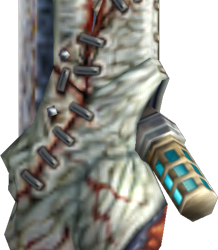
I just noticed that the skin is actually stretched over the blade, rather than being what the blade’s attached to. Gross, but I never expected Khezu weapons to look pretty. There are also weapons which emphasize the monster’s electric aspect, like this Gunlance called the Full Voltage:

It still has Silent Hill vibes due to its “rusty hospital” aesthetic, and looking at it long enough reveals little details it inherited from Khezu. Speaking of hospitals, there are a couple of weapons based off of syringes, such as the Khezu Syringe, which is a Light Bowgun, and a Lance from MHFG that’s literally a giant hypodermic needle, but I didn’t want to show those off in case they triggered anyone with needle phobia. The last weapon I’m gonna show will be very familiar to those of us who’ve played the Rise demo a lot: the Insect Glaive known as the Bolt Chamber!

I like the green tube running from the sac between the blade and the shaft of the glaive; according to the Bolt Chamber’s in-game description, it uses that “pulsating device” to steal energy from its targets. If you mentioned that to me before I grabbed its image for this review, I probably would have asked how it did that. If you then pointed out the mouth at the glaive’s end, I would have thanked you for cursing me with the knowledge of its existence. Seriously, I’ve used this thing probably more than 20 times, and until I saw this render, I never noticed that. As for the armor, here’s the Blademaster Khezu Armor from MHGU:
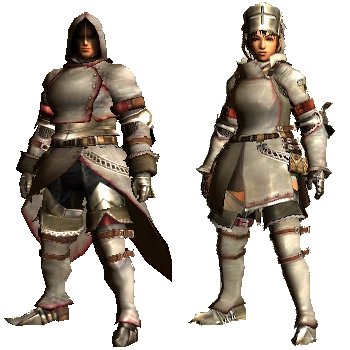
The male armor here is almost identical to the one from Rise--which sadly doesn’t have any pictures on the wiki yet--and yes, it does look like the main character from Assassin’s Creed. The female armor, on the other hand, looks almost like a nurse’s outfit, especially with that metal thing on the woman’s head with the cross. The more I look at this equipment, the more I feel like they wanted people to think of Silent Hill, and if so, that’s pretty cool. I’ve got another armor set to show you; the Gunner version of the Khezu R Armor from MHGU:
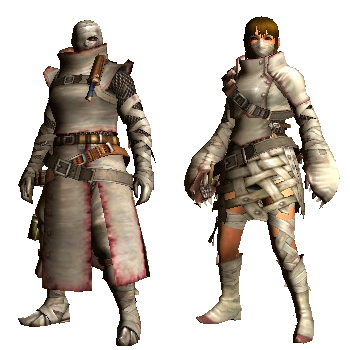
Jesus, is this an armor set or a medical emergency? I can’t imagine bandages are very effective at protecting your body from physical damage, but thankfully it looks like most of them are just covering actual armor...meaning that the people who designed this stuff in-universe wanted the people wearing it to look like they were in an accident. Not sure I get why, but I’m not here to--actually, I am here to judge, so never mind; it’s gross. Also the female set has Khezu mouths as arm coverings, which is someone’s fetish, I’m sure. The equipment as a whole is macabrely interesting (TIL that macabrely is a real word) and calls to mind a fascinating horror game franchise, so 8/10.
Final Thoughts and Tally: I figured that Khezu was gonna be interesting, but I didn’t know how far the devs would take the horror theming. Everything about this monster is creepy; it looks disturbing, it acts even worse, and its equipment makes me feel like I need a tetanus shot just from looking at it. But that’s not at all a bad thing...unless you’re really squeamish, in which case you were likely cringing this whole review. I’d apologize, but you made the choice to stick through ‘till the end. 8/10.
28 notes
·
View notes
Note
hello! i would like ur 40 song wiblur playlist
anon thank you so much for asking <333 while it would’ve been easier to just drop the link i have so many thoughts about everything so i explained why every single song has its spot on this list which was IMMENSELY fun for me
(also: if anyone does want the link i can provide both apple music and spotify but if u would like the apple music link i’d rather it be through dms or an ask off anon that i can make private!)
another also: i bolded all the songs for ease of perusing if you don’t want the director’s commentary and bolded + italicized the ones that i think fit Very Well
another another also: wrote the second bit of this on my laptop and the keyboard is p funky so if there are any typos or things that do not make sense i will try to fix them asap haha
saint bernard by lincoln: this is one of those like. Dream SMP Songs that i added because it fits into so many different relationships and plot lines and arcs but i think there’s some connection to c!wlbur somewhere out there. idk i asked my friend and he said to add it so this one goes out to him
amnesia was her name by lemon demon: ghostbur song ghostbur song! mostly comes from this lovely animatic
o valencia! by the decemberists: okay this is one of those songs that only really has one lyric that fits but is an absolutely banger so it’s here anyway. you’ll also notice a trend of quasi love songs that i relate to c!wilbur’s perception of l’manburg and i think this song shows this in a really cool way, esp with the chorus (‘and i swear to the stars i’ll burn this whole city down’ is The Line)
achilles come down by gang of youths: another one of those Dream SMP Songs. i think this fits better with c!tommy but i like it too much to remove it. this is a somewhat common trend with the earlier songs on this playlist (i’ve been building this thing since january, for reference)
brave as a noun by ajj: another Dream SMP Song. i think certain verses fit better than others when it comes to wilbur’s character but that ones that work really work
harness your hopes by pavement: a song that is one here for vibes alone. i have no idea what these lyrics mean. all i know is that i heard it, thought of c!wilbur, and put it on the playlist. thank you all for being here
evelyn evelyn by evelyn evelyn: sad-ist made this a tommy and tubbo song (as she should) so it’s validity on this playlist is questionable but folks used to compare it to wilbur and tommy’s relationship during the pogtopia arc and i think some points were made there
the execution of all things by rilo kiley: i’m so excited to get here because this was the first song i put on the playlist that i think really works and i thumb nailed an animatic for the last verse and november 16th so! i think it’s a good l’manburg song and the last verse has some good ghostbur lines (‘and lately you’re all alone with nothing left but sleep/but sleep never comes to you, it’s the guilt and forever wakefulness of the weak’)
i’m just your problem from adventure time: this ones a bit tricky since at is my favorite show of all time and i cannot detach this song from its in-show context very well but there is a very cool animatic with this song that landed it a spot on the playlist
man burning by josh ritter: almost became an animatic but the audio i wanted to use (which i recorded at a josh ritter concert and it’s just him and his guitar and there’s echo and it’s very haunting and pretty) has my stepbrother singing in the background and i could not edit it out so. that will probably not happen. but anyways the only hole i would pick in this song is that it’s mostly about self sabotage which isn’t really applicable but i think the imagery is cool
mamma mia by abba: here me out. here me out. this is another song that fits so well and i have spent so many hours thinking about this and somewhere there is a note on my phone explaining how every single line relates to c!wilbur’s entire arc from founding l’manburg to the resurrection (made when we thought gbur was going to get resurrected in january) and just. the metaphorical ‘you’ is l’manburg does this make any sense (another almost animatic except now that wilbur’s actually back it might become an actual animatic)
the other side of paradise by glass animals: no idea why this is here other than being a Dream SMP Song. it’s good tho
infinitesimal by mother mother: they saaaaay it stared with a big bang but they saaaaaaaay it came out of a small thing latelyyyyy i’ve been feeling like a big bang You Know
curses by the crane wives: had a thing drawn out for this song showing the comparisons between c!wilbur and c!niki because of the chorus and i think the last two lyrics of said chorus are the best thing about this one
lonely eyes by the front bottoms: gotta admit that i have no idea how this song got on here but i’ve come to associate it with ghostbur based on vibes alone. it’s a friendly song he’s a friendly ghost it works. the other tfb song coming up fits a bit better methinks
king of new orleans by better than ezra: not to put better than ezra on my c!wilbur playlist but like. something about the whole ‘tasing something up to let it fall’ motif makes me think
get me away from here, i’m dying by belle and sebastian: another almost animatic song (there’s a trend here). not only does the story told in this song work i like the lines ‘play me a song to set me free/nobody writes them like they used to so it may as well be me’ in relation to my l’manburg
montgomery forever by the front bottoms: certain bits and pieces of this song fit so well, specifically the chorus and those bits in the last two choruses Yeah (’montgomery forever and ever and ever and now they’re blowing it up/(x2)/as you started laughing and crying and trying to explain how all you want to do is leave’)
don’t look back in anger by oasis: out of all my almost animatic songs, this one got the furthest. the animatic, which I got pretty far in thumbnailing, was about wilbur and tommy and kind of drawing comparisons between their characters, also about the revolution in general. maybe i’ll finish that animatic one day idk
snow by ricky montgomery: i wish i had a link for this so bad but!! saw art on twitter!! with the lyric ‘bury me six feet in snow’!! and went ahfsdjfk!!
burning pile by mother mother: a Dream SMP Song. also a jam there’s no real specific connection for this one but i think it could fit in a couple of ways
rounds by the oh hellos: in the same position as snow except it was on tumblr..... @ whoever made this comic i saw these lyrics in your brain is massive and your art is incredible
lovely by mt. eddy: on here for vibes alone. there’s something in the lyrical content too, but my thoughts in that regard are not very fleshed out
adventures in solitude by the new pornographers: ah yes..... the song that prompted this all...... this is a beautiful and incredibly well written song and if you’re going to listen to any song off of this playlist i’d encourage you to listen to this one. it’s place of here is mostly cause of the chorus but the imagery in the verses could all represent a part of c!wilbur and i’d love to explore that more
caught in the middle by paramore: obligatory paramore song. i think it got on here because limbo = ‘middle’ but i’m not quite sure. on the verge of being deleted if i can find a better pmore song
delicate by damien rice: one of the oddest songs on this list and i am well aware that it sticks out like a sore thumb. a song that’s on here pretty much because of one lyric, which is ‘and why’d you sing hallelujah/if it means nothing to you’ which i related to both eret’s betrayal and how my l’manburg is hallelujah yknow
bang! by ajr: almost animatic song. i think we all know what the bang is here
somewhere only we know by lily allen: ik i said don’t look back in anger has the most potential to get made into an animatic but this song might actually take it place. on par with adventures in solitude in terms of how pretty of a song it is, and probably even moreso. it’s kind of turned into a ghostbur song in my head, and makes me cry like an infant child every time i hear it
a pearl by mitski: i cannot defend this song’s place on here past the line ‘it’s just that i fell in love with a war and nobody told me it ended’
eight by sleeping at last: the official c!wilbur song needs a spot on here <3 if i can dig up the clip of cc!wilbur talking about this song in relation to his character i’ll add it but until then yeah <3
always by rilo kiley: no idea why this is on here but it fits well!! could not tell you why!! banger!!
celebration guns by stars: it’s a hauntingly beautiful song about war, and kind of one of those that necessarily isn’t about wilbur but moreso his place in the story? idk how to explain it but yes
passerine by the oh hellos: it’s. it’s from the . the fic. yeah h
oh, you are the roots that sleep beneath my feet and hold the earth in place by bright eyes: added this after the real resurrection and i think it’s because fo the imagery? also the last verse
we are beautiful, we are doomed by los campesinos!: all i have to say is ‘i cannot emphasize enough that my body/is a badly designed, poorly put together vessel/harboring these diminishing, so called vital organs/i hope my heart goes first, i hope my heart goes first!’ has always made me think of pogtopia era wilbur :(
dead weight by jack stauber: no real connection other than eret played this song during a break during the ghostbur’s january ‘resurrection’ and i heard it and went :0
point me at lost lands by tired pony: gives me season on l’manburg vibes..... i love how free and passionate it sounds and that's p much the only reason it’s on this list haha
ghosting by mother mother: added this five seconds ago because i could not BELIEVE it was not on here. ghostbur song. mans sang it on that one stream with the reverb and everything. the lyrics ‘i will be kind and i’ll be sweet/if you stop staring straight through me’ hit particularly hard back when everyone thought that ghostbur was actually wilbur in disguise
#oh man. oh man#this was so fun ty anon#i'll do some spell checking after i write my english paper but for now take this#wooo boy#also if i interpreted canon wrong i do apologize i am here to have fun and think about fictional character#anon#ask
8 notes
·
View notes
Text
The Three Three Musketeers (or Where The F*ck Did All The Stupid Hats Go)
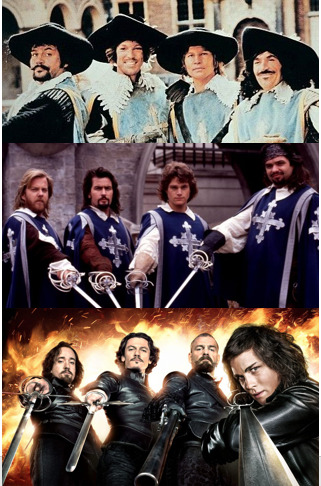
I read The Three Musketeers and then I watched the 1973, 1993 and 2011 adaptations. Which one wins tho?
Adaptation is a fascinating concept, especially of texts which are frequently adapted or parodied. After I rewatched the 2005 Pride and Prejudice I was reminded how weirdly divisive the two dominant adaptations of that book are. A lot of people consider the 2005 to be an inferior betrayal of the 1990s BBC version. I actually prefer the 2005 because I think Matthew McFadyen’s Mr Darcy is a wonderfully complex character. McFadyen imbues Darcy with social awkwardness and anxiety, which Lizzie misinterprets as his pride. To overcome the “Lizzie doesn’t fancy him ‘til she sees his house” debate, director Joe Wright includes a moment where Lizzie glimpses Darcy alone with his sister. He’s comfortable, his body language is completely different, and he’s smiling broadly. That moment really sold me on the entire film because it made Darcy a full character and was a really simple addition that rounded out the story. I still like the 90s version but for me, it’s the 2005 that takes first place. (Although an honourable mention for Pride and Prejudice and Zombies because it is an excellent romp.)
Look: adaptation is always a complicated topic. You can’t untangle one adaptation from another, because it’s pretty rare that somebody adapting a classic text like Pride and Prejudice or The Three Musketeers is not already familiar with existing adaptations. The most recent adaptation of any classic text is not simply an adaptation of that text, but the next step in a flow chart that includes all the previous adaptations and the cultural context of the newly created product. These three adaptations of Dumas’ 1844 novel are all texturally and stylistically very different, and two of them diverge significantly from the original text. What I found truly fascinating was what all of them had in common, and what each new era (these were made at around 20 year intervals) decides to add or remove. What do all these movies agree are the essential parts of the story, and what are some adaptations more squeamish about including from Dumas’ original narrative?
Before we dive in, no I have not seen every single adaptation of the story, that would be a dissertation level of research and I do actually have things to do right now (although, I will admit...not many.) I’m looking at these three Hollywood adaptations because they all had star studded casts (for the era they were made in), they’re all English language, and (crucially) they were all easily available on the internet for me to stream.
What are the essential ingredients of a Three Musketeers adaptation?
Firstly, there should be at least three musketeers. Secondly, D’Artagnan (Michael York 1973, Chris O’Donnell 1993, Logan Lerman 2011) should be a young upstart who is introduced part way through a sword fight. He should also have silly hair. He is also consistently introduced to the musketeers in all three films by challenging them each individually to duels at noon, one o’clock and two o’clock.
The films all maintained some elements of the original “Queen’s Diamonds” storyline, and featured the Queen, Milady and Constance. The characterisation of these three varied a lot.
Our villains in each case are invariably the Cardinal, his pal Rochefort (who always has an eyepatch, although this trope is not in the book and is actually attributable to the way Christopher Lee is styled in the 1973 film), and Milady de Winter. Satisfyingly, at least two of the villains usually wear red because they’re bad. Red is for bad.
All three are very swashbuckling in tone, have elements of physical comedy, and two of them include one of the three valet characters Dumas wrote into the original story, Planchet (1973 Roy Kinnear, 2011 James “ugh why” Corden). They also all bear the generic markings of the movies made during the same era, our 70s D’Artagnan feels like a prototype Luke Skywalker. The 90s version features a random martial arts performer. The 2011 version has CGI and James Corden in equal measure (read: far too much of both.)
What are the big differences?
I’m going to divide this category into three main segments: character, story and style. My own three musketeers, the three musketeers of movie making.
Character
D’Artagnan
D’artagnan in the book comes across as a pretty comical figure. He’s nineteen and there’s something satisfying about how similar Dumas’ caricature of a nineteen year old is to a modern character of the same age. He’s overconfident, has a simplistic but concrete set of morals, and falls in love with every woman he sees. If D’Artagnan were a 2021 character, he’d really hate The Last Jedi, is what I’m saying. He’d definitely have a tumblr blog, probably a lot like this one, but perhaps a scooch more earnest. He really loved The Lighthouse but he can’t explain why. Isn’t it nice to know that awkward nineteen year olds have been pretty much the same for the last three hundred years at least?
In all three films he’s kind of irritating, but at least in the 1973 this feels deliberate. This version has a certain “Carry On Musketeering” quality to it and D’Artagnan is your pantomime principal, he’s extremely naïve and he takes himself very seriously. This is the closest D’Artagnan to the book, and the 1973 is, in general, the film which adheres most faithfully to that source material.
The 1993, which is (spoiler alert) my least favourite adaptation, has Chris O’Donnell as the least likeable D’Artagnan I’ve come across. I’ve only seen O’Donnell in one other thing, the Al Pacino movie Scent of a Woman. He’s bearable in that because he’s opposite Al Pacino, and so his wide-eyed innocence makes sense as a contrast to Pacino’s aged hoo-ah cynicism. Rather than being introduced in a practice sword fight with his father, as in the other two films, D’Artagnan is fighting the brother of an ex-lover. This captures the problem with the film in general: this adaptation wants D’Artagnan to be cool. He is not. The comedy of the 1973, and indeed the book, comes from D’Artagnan being deeply uncool, and from his blind idolisation of the deeply flawed Musketeers who actually are cool, but not necessarily heroic, or even good people. Their moral greyness contrasts with D’Artagnan’s defined sense of right and wrong, but he still considers them to be role models and heroes.
2011′s version also suffers from “Cool D’Artagnan” syndrome, with the added annoyance of that most Marvel of tropes: the quip. One of the real issues with this film is that the dialogue has a lot of forced quippery that doesn’t quite land, and the editing slows the pace of the entire film. D’Artagnan’s first interaction with Constance is a bad attempt at wit which Constance points out isn’t very funny. The problem is that Constance has no personality so there’s no real indication that she’s in any position to judge his level of wit. She’s just vague, blonde and there: three characteristics which describe an entire pantheon of badly written female characters throughout the ages. Cool D’Artagnan also means that Constance should be additionally cool, because in the book, Constance is older than, smarter than and over-all more in charge than D’Artagnan.
Female Characters
Let’s go into this with an open mind that understands all these films were made in the sociological context of their decade. The 1973 version would absolutely not be made in the same way now. Constance is a clumsy cartoon character who is forever falling over and accidentally sticking her breasts out. This is not the character from the books, but does at least leave an impression on the viewer one way or another.
In contrast, the 1993 has a Constance so forgettable I literally cannot picture her. I think she holds D’Artagnan’s hand at the end. That’s all I can say on the subject.
The 2011 has Gabriella Wilde in the role, and absolutely wastes her. Anyone who’s seen her in Poldark knows that she can do sharp-tongued beautiful wit-princess with ease. It’s the writing of this film that lets her down, in general, that’s the problem with it. The storyline and design are great, but the actual dialogue lacks the pace and bite that a quip-ridden star vehicle needs. This Constance is given simultaneously more and less to do than the Constance of the original book, who demonstrates at every turn the superiority of her intellect over D’Artagnan, but doesn’t get to pretend to be a Musketeer and whip her hat off to show her flowing golden hair like she does in the 2011.
The best character, for my money, in The Three Musketeers is Milady de Winter. Even Dumas got so obsessed with her that there are full chapters of the book written from pretty much her perspective. In the book, she’s described as a terrifying genius with powers of persuasion so potent that any jailor she speaks to must be instantly replaced. My favourite Milady is absolutely Faye Dunaway from 1973. She’s ferocious and beautiful and ruthless, but potentially looks even better because the portrayals in the other films are so very bad.
The 1993 version has your typical blonde 90s baddie woman (Rebecca De Mornay), she wouldn’t look out of place as a scary girlfriend in an episode of Friends or Frasier. 2011 boasts Milla Jovovich who presents us a much more physical version of the character, even doing an awkwardly shoe-horned anachronistic hall of lasers a la Entrapment except instead of lasers its really thin pieces of glass? The “yeah but it looks cool” attitude to anachronism in this film is what makes it fun, and Jovovich’s Milady isn’t awful, she’s just let down by a plot point that she shares with 1993 Milady. Both these adaptations get really hooked on the fact that Athos used to be married to Milady at one time (conveniently leaving out the less justifiable character point that Athos TRIED TO HANG HER when he found out she had been branded as a thief - doesn’t wash so well with the modern audiences, I think.) Rather than hating/fearing Milady, the two modern adaptations suggest that Athos is still in love with her and pines for her. This detracts from Athos’ character just as much as it detracts from Milady’s. Interestingly, and I don’t know where this came from (if it was in the book I definitely missed it), both films feature a confrontation between the two where Athos points a gun at Milady but she pre-empts him by throwing herself off a cliff (or in the 2011, an air-ship.) I think both these versions were concerned that Milady was an anti-feminist character because she’s so wantonly evil, but I disagree. Equality means it is absolutely possible for Milady to be thoroughly evil and hated by the musketeers just as much as they hate Rochefort and the Cardinal. If you want to sort out the gender issues with this story, round Constance out and give her proper dialogue, don’t make Milady go weak at the knees because of whiny Athos (both Athos characters are exceedingly whiny, 1973 Athos is just...mashed).
The Musketeers
These guys are pretty important to get right in a film called The Three Musketeers. They have to be flawed, funny but kind of cool. Richard Chamberlain is an absolute dish in the 1973 version, capturing all those qualities in one. Is it clear which version is my favourite yet?
Athos is played variously by a totally hammered Oliver Reed (1973), a ginger-bearded Kiefer Sutherland (1993) and a badly bewigged Matthew McFadyen (2011). They all have in common the role of being the most level-headed character, but the focus on the relationship between Athos and Milady in the 93 and 11 editions undermines this a lot. Athos should be cool and aloof, instead of mooning over Milady the entire time. The 2011 gives Athos some painfully “edgy” lines like “I believe in this (points at wine) this (flicks coin) and this (stabs coin with knife.)...” which McFadyen ( once oh so perfect as Mr Darcy) doesn’t quite pull off.
Porthos seems to be the musketeer who is the most different between interpretations. A foppish dandy in the 1973, a pirate (!?!) in the 1993, and then just...large in 2011. I think the mistake made in the 2011 is that large alone does not a personality make. There are hints at Porthos’ characterisation from the book: his dependence on rich women for money and his love of fine clothing, but these are only included as part of his introduction and never crop up again through the rest of the film. Pirate Porthos in 1993 is... you know what, fine, you guys were clearly throwing everything at the wall and seeing what stuck.
Aramis is our dishy Richard Chamberlain in 1973, followed by womanising Charlie Sheen in 1993 and then strikingly suave Luke Evans in 2011. I actually didn’t mind Luke Evans’ interpretation, his dialogue is forgettable but his sleek charm stuck in my head. For some reason, this version has Aramis working as a parking attendant for horses, it worked for me as a fun A Knight’s Tale-esque bit of anachronistic character development. Charlie Sheen has never managed to appear likable or attractive to me and so his role in the 1993 falls flat. In fact, in that edition there’s not much distinction between the musketeers as characters and they’re all just very 90s and American. As anyone who’s read this blog before will expect, I think Keanu Reeves as Aramis would have really upped this film’s game. In fact, Keanu Reeves as Aramis, Brad Pitt as Athos and Will Smith as Porthos could have been the ultimate 90s adaptation, throw in DiCaprio as D’Artagnan and Roger Allam as the Cardinal and I’m fully sold.
The King and Queen
All three films try and do the “Queen’s Diamonds” storyline, but only the 1973 actually includes the Queen’s affair with Buckingham. The queen, played by Geraldine Chaplin, is a tragic romantic figure (she doesn’t have a tonne to do besides being wistful and sighing over Lord Buckingham). The king is played as a frivolous idiot by Jean-Pierre Cassel (voice dubbed by Richard Briers). He doesn’t really think of the queen as a person, more as a possession that he doesn’t want Buckingham to have.
In the 1993 version, Buckingham doesn’t really feature, and it’s the queen’s refusal to get off with the Cardinal that prompts his fury at her. The book does touch on the Cardinal’s desire for the queen, but it’s placed front and centre in 1993. This is definitely the boobsiest version, with quite a lot of corsetry on show and a cardinal who hits on literally all the women. The king is shown as a stroppy teenage boy under the thumb of the cardinal, who just wants to ask the queen to the dance but doesn’t have the nerve. The king is, essentially, a Fall Out Boy lyric.
The 2011 also seems to be really squeamish about the idea of the queen having an extramarital affair. It paints Buckingham (played with excellent wig and aplomb by Orlando Bloom) as a stylish villain, who’s advances the queen has rejected. Like the 1993 version, the King is a feckless youth rendered speechless by the presence of his wife. Both these versions want the King and Queen to be happy together, while the 1973 doesn’t give a fuck.
The Cardinal and his Cronies
The cardinal is kind of universally an evil creepy guy. One of the characters from the 1973 version who actually left the least impression on me, played by Charlton Heston. I think he’s overshadowed in my recollection by cartoonishly evil Christopher Lee as Rochefort. Lee’s Rochefort is dark, mysterious and wonderfully bad, and so influential that all other incarnations’ design is based on him. The 1993 version had truly over the top Michael Wincott as a character I could honestly refer to as Darth Rochefort from the way he’s framed, while 2011 boasts a chronically underused Mads Mikkelsen in the role.
Cardinal-wise, 1993 was my favourite with Tim Curry in all his ecclesiastical splendour. It was disappointing that everything about this film, including the Cardinal’s sexual harassment of every single female character, really didn’t work for me. Tim Curry is a natural choice for this role and gives it his campy all.
2011 has not one but two trendy bond villain actors, with Mikkelsen working alongside Christoph Waltz who was...just kind of fine. I was really excited when he appeared but he didn’t really push the character far enough and left me cold.
Story
The story is where the different adaptations diverge most completely. 1973 follows the plot of the novel, D’Artagnan comes to Paris, befriends the Musketeers and becomes embroiled in a plot by the Cardinal to expose the Queen’s affair with Buckingham through the theft of two diamond studs. D’Artagnan, aided partially by the musketeers, must travel to London to retrieve the set of twelve studs gifted by the King to the Queen, and by the Queen to Buckingham. He does so, the plot is foiled, he’s made into a musketeer! Hurrah, tankards all round.
The 1993 version drops D’Artagnan into the story just as the Cardinal has disbanded the Musketeers. I found the plot of this one really hard to follow and I think at some point D’Artagnan ended up in the Bastille? There was this whole plot point about how Rochefort had killed D’Artagnan’s father. In the original, and in the 1973 version, D’Artagnan’s entire beef with Rochefort is rooted in a joke Rochefort makes about D’Artagnan’s horse. I guess for the producers of this one, a horse insult is not enough motivation for a lifelong grudge. That is really the problem with the entire film, it forgets that the story as told by Dumas is set in a world where men duel over such petty things as “criticising one’s horse”, “blocking one’s journey down a staircase” and “accusing one of having dropped a lady’s handkerchief.” The colour palette and styling are very 90s “fun fun fun”, but the portrayal of the cardinal and the endless angst about D’Artagnan’s father really dampen the mood.
The 2011 version, this is where the shit really hits the fan. We meet our musketeers as they collaborate with Milady to steal the blueprints for a flying ship (it’s like a piratecore zeppelin). Milady betrays them and gives the plans to Buckingham, they all become jaded and unemployed. D’Artagnan arrives on the scene (his American accent explained by the fact that he’s from a different part of France) and befriends the Musketeers. The cardinal tries to frame the queen for infidelity by having Milady steal her diamonds to hide them in Buckingham’s safe at the tower of London. Something something Constance, something something help me D’Artagnan you’re my only hope. MASSIVE AIRSHIP BATTLE. The king and queen have a dance. James Corden cracks wise.
It seems like as time has passed, producers, writers and directors have felt compelled to embellish the story. I think, specifically in the case of the two later versions, this is because they wanted the films to resemble the big successes of the period. Everybody knows no Disney hero can be in possession of both parents, so D’Artagnan is out to avenge his father like Simba or Luke Skywalker. In the 2011 version, the plot is overblown and overcomplicated in what seems like an attempt to replicate the success of both the Sherlock Holmes and Pirates of the Caribbean franchises. Remember the plot of Pirates of the Caribbean: At World’s End? No, me neither.
Style
The style of these films grows increasingly wild along with the plots as time passes. The 1973 features a lot of slapstick comedy, some of which really made me cackle, and some of which was cringeworthily sexist (Constance’s boobs through the window of a litter.) That’s the 70s though! I love The Godfather but Diane Keaton’s character is unbelivably dull and annoying. Star Wars features a pretty good female character but she does end up in that bikini. The 70s seems to be a time of movies that were great except for their occasional headlong dive into misogyny. That doesn’t mean the entire movie is bad, it just means it’s suffering from the consequences of being made in the 70s. There were other consequences of this, I doubt many modern productions could get away with physically injuring so many of it’s cast members. From a glance down the IMDB trivia page, this film yielded a higher casualties to cast ratio than the My Chemical Romance Famous Last Words music video, and that’s a hard figure to top.
The 1993 version is a Disney feature and suffers from having a thin sheen (not Charlie in this instance) of “Disney Original Movie” pasted over every scene. It looks like The Parent Trap might be filming in the adjacent studio a lot of the time. The vibrancy of the colours makes the costumes look unrealistic, while the blandness of the female characters means this movie ends up a bit of a bland bro-fest. Also occasionally the sexual and violent moments really jar with the overall tone making it an uneven watch. One minute it’s Charlie Sheen cracking jokes about trying to get off with someone’s wife, the next minute you see Milady throw herself off a cliff and land on the rocks. Weird choices all round.
The 2011 version, as I’ve already mentioned, was trying to borrow its style from the success of Sherlock Holmes and Pirates of the Caribbean, with a little Ocean’s 11 thrown in. The soundtrack flips between not quite a Hans Zimmer score and not quite that other Hans Zimmer score, and after the success of Stardust it ends with a Take That song (for it to match up to the story it should have been Take That feat. Harry styles imho). Visually, there’s some fantastic travel by mapping going on, there’s far too much CGI (one of my friends pointed out that the canal in Venice seemed to be full of Flubber). Everyone is dressed in black leather, and there are not enough big hats at all. One of the best things about Musketeers films is that they’re an excuse for ridiculous hats, and in a film with a quite frankly insane visual style, I’m surprised the hats didn’t make it through. The cast, unfortunately, really lack chemistry which means the humorous dialogue is either stilted or James Corden, and the editing is just very strange. It’s one of those films that feels about as disjointed as an early morning dream, the one where you dream you’ve woken up, gotten dressed and fed the cat, but you actually are still in bed.
Conclusion
Adaptations focus on different things depending on the context they were created in. The 2005 Pride and Prejudice is deliberately “grittier” than its 1990s predecessor, at a stage when “grit” was everywhere (The Bourne Identity, Spooks, Constantine). The Musketeers adaptations demonstrate exactly the same thing: what people wanted in the 70s was bawdy comedy and slapstick with a likeable idiot hero, the 90s clearly called for... Charlie Sheen and bright colours, and the 2010s just want too much of everything and a soundtrack with lots of banging and crashing. The more modern adaptations simplified the female characters (although the 1973 version definitely is guilty of oversimplifying Constance) while over-complicating the plot. There’s a lot of embellishment going on in the 2011 version that suggests the film wasn’t very sure of itself, it pulls its plot punches while simultaneously blindly flailing its stylistic fists.
The film that works the best for me will always be the 1973 because it’s pretty straight down the line. Musketeers are good, Milady is evil, falling over is funny and the King’s an idiot. The later adaptations seem to be trying to fix problems with the story that the 1973 version just lets fly. The overcorrection of Milady and the under characterisation of Constance is the perfect example of this. If you want your Musketeers adaptation to be more feminist, don’t weaken Milady, strengthen Constance. Sometimes a competent female character is all that we need. A Constance who is like Florence Cassel from Death in Paradise or Ahn Young-yi from Misaeng could really pack a punch.
I adored the energy of the 2011 adaptation, I loved how madcap it was, I loved how it threw historical accuracy to the wind. I thought the king was adorable, and I really enjoyed seeing Orlando Bloom hamming it up as Buckingham. I was genuinely sad that the sequel the ending sets up for never came, because once they got out of the sticky dialogue and into the explosions, the film was great fun. It was a beautiful disaster that never quite came together, but I really enjoyed watching it. I love films that have a sense of wild chaos, some more successful examples are The Devil’s Advocate, Blow Dry and Lego Batman. I think the spirit of going all out on everything can sometimes result in the best cinematic experience, it’s just a shame the script wasn’t really up to muster for 2011 Musketeers.
I’m excited to see what the next big budget Musketeers adaptation brings, even if I’m going to have to wait another ten years to see it. I hope it’s directed by Chad Stahelski, that’d really float my boat (through the sky, like a zeppelin.)
10 notes
·
View notes
Text
Part 2
This is part 1.
Can you tell how tired I was getting by the end? This is life under meds, but given the other benefits (I think?), I’ll take it for now.
When I woke up the next morning, I had a whole lot I was thinking about and it’s stuff I want to say given I said a lot, but didn’t cover this stuff. I’m still happy with part 1, I think that’s just how I write, moving from subject to subject more or less organically and it does show me to more unstructured even if there is a vague plan for how I want the piece to go.
Anyway let’s get going.
As always, mild spoilers for well, everything. If you haven’t seen this stuff and are mildly interested in watching them then ah, you may have a lot of catching up to do. I don’t think I’ll drop any real hard spoilers for anything but you never know.
Ghost In The Shell is an Outsider story
There are whole stacks of lore you could dive into with Stand Alone Complex in particular, with Motoko having been in an aircraft accident and getting her first shell (cyber-body) at a very early age, what that means, the thing with Kuze (avoiding spoilers here), and the extended cast - not that Paz, Boma and even Ishikawa get a whole lot of time anyway - but it’s not really that important.
Looking at just Mamoru Oshii’s 1995 film, and even more-so his 2004 film Innocence (not really a sequel but usually regarded as such), the narratives cast the characters very much as Outsiders. In the first film, Section 9 is already at odds with the government in general and while it’s subtle, Aramaki as a department head is certainly different from his contemporaries, even if we don’t see much of it - again, so much more of this in Stand Alone Complex. Motoko’s early conversation with Togusa in the first film is probably the most telling as far as playing it loud. She speaks in pragmatic terms to why he’s there, but this is a precursor to what will ultimately transpire for herself at the conclusion of the film, something very intentionally written into the film. Batou is also an Outsider in more ways than one, not only in the role he plays in the department but in the very clear personal boundary between him and Motoko. There are boundaries between Batou and everyone and they become more apparent in the second film. Togusa is easy pickings so I’ll leave him alone, suffice to say if the film needs one, he’s the audience’s window of ignorance which is why he’s discarded so willingly half way in. He gets his time in the spotlight in Stand Alone Complex and it’s pretty amazing.
As for Motoko... I admit it is difficult separating my understanding of her character from Stand Alone Complex and attempting to just isolate what’s shown of her in the first film but I’ll try.
I mentioned the film’s centrepiece montage in my previous journal, in which we might say Motoko is the centrepiece but if so, she probably shares it with the city itself, and I feel much more is being said about the two together rather than separated simultaneously. This would be one of the first indications of Motoko’s sense of identity, of otherness, isolation, questioning. Again the scene that plays it most loud would be diving on the boat and her speech to Batou. There are other moments tho; single frames of her face, looks, movements that are lingered on, I feel like Oshii is constantly telling us about her and what she’s going to do, but more important than that, why she’s going to do it and how she feels.
Ghost in the Shell is a film about great emotion, and not like I’d know because it’s been a long time since I’ve looked into the discourse around it, but I suspect no-one really talks about it as a film about feelings.
I realise these days I talk more and more about moods and art being mood pieces. I labelled my Instagram account as being “A catalogue of moods” and I’m very fond of the use of the word in vernacular. It might seem flippant but it’s immensely empowered, especially for me as an individual when I understand my moods and can translate them into, via and thru art. I do appreciate many struggle with Oshii’s cinematic language as it can appear cold and detached and that’s fine, but it’s anything but for me - it’s immensely emotionally charged, it just appears differently to what audiences are perhaps accustomed to seeing. It’s a different language that perhaps takes time to learn, but it’s all there.
This couldn’t become more evident than in Innocence (the Ghost in the Shell 2 moniker I think was a western addendum). Batou takes centre stage and is immediately presented as bluntly as possible as an Outsider, reaffirmed later by Aramaki who also cements Togusa’s position in limbo.
I should pause and say that within the GitS canon, I feel Togusa is definitely embraced by Section 9, so he’s not wholly an Outsider to the department, but for obvious reasons, he doesn’t fully share all of their daily or philosophical concerns - hence not wholly. He would also definitely be an Outsider to most other members of the force after joining Section 9, but unfortunately I’m not here to love Togusa, poor guy - I feel like he’s always a bit unloved. Someone write a giant essay in service to his greatness. He actually is great.
But I adore Batou in Innocence. I love his story, his struggle, his emotion. I love how present Motoko is without ever appearing on screen and then when she does, the impact she has on everything, especially with the lines she delivers, one of which I quoted to open the last journal. Batou is in many ways a shadow of what Motoko was and is/has become, just in physical form, mirroring her in a real world manifestation with the natural physical limitations that comes with.
For some reason I feel like I need to inject a comment about Batou putting the jacket/vest on Motoko’s body. I don’t know if people perceive this as an act of masculine modesty but it’s not how I read it. I did stumble on this action for years but as I began to interpret the films as Outsider stories, I realised that he does this as an act of inclusion, and that Motoko consents, permits him to and doesn’t immediately react with violence or technological recourse we know she is well capable of, indicates it’s mutual. Their inclusion isn’t just about the boundaries of the Section 9 department but extends beyond that, an inner circle that may only contain the two of them - inside which there are still boundaries between them Batou can never cross. Those boundaries become infinitely more apparent after the final events of the first film, and the second film effectively is all about how he feels about them. He is an ultimate Outsider, but so is Motoko in the state she now is in.
Section 9 is a department of stray dogs. Individuals who haven’t quite fit in where they belong, and found belonging with one another. Then, after a time, one of them moves on - at the conclusion of the first film, and then another feels an almost permanent and ultimate sense of separation - more or less the duration of the second film.
Ghost in the Shell isn’t about technology and sentience and hacking and corporations at all. It’s about loneliness and belonging and acceptance and affection. It’s about how that feels.
I’m Not Sure Why People Struggle With David Lynch Films
I need to stop talking about anime. Honestly I looked at the list at the start of the last journal and thought hell yea Sky Crawlers, Jin-Roh, Haibane Renmei and Lain let’s unpack some shit! but honestly I’ll run out of time and I should really draw from a variety of mediums and sources.
OK I’m not being facetious when I say Lynch’s films are fairly straight-forward narrative-wise. Again, it’s hard for me to position myself in a place where I’m not into the stuff I’m into and maybe that’s what gives me the cinematic language familiarity to parse them but that just sounds like wanker bullshit to me. I don’t mind if folks don’t like Lynch films, that’s fine. But they aren’t difficult.
So in the context of everything else, even on that short list on the last journal, plus how I keep trying to shift the discussion of works from the pragmatic reading of them to an emotional reading of them from a mood perspective, I feel as tho the same process can be applied to Lynch. So much about his films are about how they make you feel, or I’ll say - how they make *me* feel. It might be grandiose to assume I’m feeling the correct emotion, that these are the moods that David Lynch himself is attempting to create and evoke and thus, I am interpreting them correctly but hey - I enjoy the hell out of the films, feel I understand them and watch them over and over again so that’s all I’m basing it on.
That’s not to say there are things I dismiss as meaningless or that I don’t understand in his films, it’s just that I don’t have to parse them immediately at first watch and perhaps that’s the audience’s problem. I don’t know if reverse-diagnosis is appropriate but looking at how much hand-holding there is in other directors’ films might be just as telling. I mean I saw Nolan’s Tenet and was about the least confusing thing I’d ever seen in my life but apparently *that* confused people, and you know hey that’s fair I guess, but I mean Nolan did a whooooole lot of audience hand-holding in that film, I mean, the dialogue was terrible. There was so much unnecessary exposition, which I generally find in all of his films, so if an audience can’t follow that then OK sure, Lynch is going to be a problem.
The thing is popcorn cinema is totally OK. I watch it. I really love it, I’ve written about it before, it’s good Industry. There’s a lot of great creativity in popular cinema, I don’t at all think poorly of it and I love seeing a really well produced, Hollywood picture... but I guess if that’s all you consume, and I guess if folks’ short-format episodic media (aka series - think Netflix, HVO etc.) is more or less to the same standard, then it begins to make sense that anything outside of that isn’t going to make sense.
Long story short - Lynch films tell simple stories where the feeling of the film is as important as the narrative of the film. To understand the story, you have to understand the feeling, and vice-versa.
Surprise surprise, it turns out independent and deemed “fringe” film-makers... aka Outsiders... make films about Outsiders.
Now I wouldn’t know if any of the Marvel films thematically are about Outsiders or Outsider culture, they probably are and very loudly at that, but the reason I’ve never included one in my catalogue of moods is they all read the same way. Not only are Marvel films mostly indistinct from one other to me, they’re also mostly indistinct from much of popular culture in general. That doesn’t make them bad, some of them still have some pretty awesome stunts, visfx, even parts of the narratives, funny jokes etc. in them, but on the whole they’re not useful to me as things I deem truly valuable in the long-term.
It’s OK, I’m not at all going to lament the proliferation of Marvel films, a lot of them have been pretty cool and they keep people in work. Meow meow meow “the death of cinema” mate, sure - I find it more difficult to find the sorts of films I like but that’s always been the case. Humans will do what they do, it’s not a read on cinema, it’s about being an Outsider and what that’s all about. True, maybe weird shit like Lynch and Noe might be more difficult to make, but the weird-indie corner was also dominated by white men and that needs to change, so who knows what the future holds.
Can you detect the point at which I took my meds and started getting tired?
Ghost in the Shell // Innocence // What We Want // What We’re Left With
Growing up as an Outsider, I feel as tho the first Ghost in the Shell film carries the weight of isolation, questions of identity and belonging, ultimately of acceptance, empowerment and liberation. Then Innocence brings to bear very similar moods but states that things may not necessarily change for the better, they simply change state. I love that in both narratives, the main texts of hacking or corrupt corporations, crime etc. are the least common denominators and barely relevant to heart of the films. I think about the theme of icons in Innocence, icons operatively being the dolls throughout the film, and the final image of Togusa’s daughter’s gift. As humans we assume we’re to take the position of biological humanity as representative of sentience, taking moral priority over all other beings. Earlier in the film we think Togusa is in limbo, but at the conclusion Motoko asks the question, or perhaps states that perhaps we’re all in limbo together.
I think that’s a significant part of what growing up as and being an Outsider is like, what it feels like. Christians have this saying about “living in the world but not of the world” (derived from a bible verse) and honestly I don’t think they know what it means because they just operate like a cult, but I think queers and folks with long term mental health conditions have a better idea. We are pushed out to the fringes of our social groups from an early age, long before we know or understand what’s different about us. Our peers and the adults around us do this to us because their social behaviours are so well hard-coded, even they may not even know precisely what’s different about us, they just do - and they’re right. We are different. And they don’t accept us.
Maybe I am starting to get a little more upset that weird/different art is becoming more difficult to fund and make, because it’s for us, for me. It speaks to me. You already have so much, and representation and inclusion is so important. I don’t just need queer cinema, I need weird cinema, I need moods. I need quiet, introspective, pensive, reflective, Outsider moods.
I still feel like an Outsider. I have a few people who understand more about me, but I don’t think I have a place, not in a real sense. I have never felt that. Art is one of the few places I feel any connection with anything, and connecting with people is a very odd thing to consider - honestly, I actually would really like to connect with people but the unique combination of being queer *and* autistic comorbid with bipolar makes it really tough, more difficult the older I get. And now all you want to do is fund Marvel movies. I can’t feed off of that.
I’m getting tired, I’m not making any sense. It’s time for bed.
#2021#chrono#ghost in the shell#innocence ghost in the shell#outsider culture#outsider#queer#queer culture
4 notes
·
View notes
Text
My Soulmate’s Soulmate.

Part 3
Soulmate Au-
Synopsis: Before you meet your soulmate your world is black and white, without color. When soulmates meet, their world glows with vibrancy. The reality, however, as harsh and uncommon as it is, is that you are not always your soulmate’s soulmate.
Pairings: Jungkook x Reader, Taehyung x Reader, Jungkook x Taehyung (poly!au), side pairings: minjoon
Warnings: N/A
Author’s note: YALL. im mad. i literally had to re-edit and reupload this whole chapter because tumblr fckn deleted it im so sorry :(
--
Taehyung sat on the floor of his art studio, he barely even recognized the place. He had an assistant, Jimin (who was happily married to his own soulmate), who did all of the color theory for Taehyung’s pieces. Even if Taehyung was the main director, the face of the company, Jimin’s role was vital.
Jimin, along with being his employee, was Taehyung’s best friend. He entrusted everything to Jimin.
Jimin had speculated what had happened at the restaurant and tried to give Tae as much space as possible until Tae had refused his third meal of the day. Jimin does not take skipping meals lightly.
Jimin places the plate of food he had been carrying on a cluttered, paint-stained table.
“Tae, you’ve been staring at the same piece for over four hours. Why don’t you just go talk to-“
“Out of the question.”
“Why!?”
“Because they’re already in a relationship.”
He empathized with his friend, really he did. Finding out the person you’re destined to be with forever is in a relationship with someone else has to be heart-breaking. And it’s rare. However, there is one thing that doesn’t make sense. Jimin paused for a few moments.
Why wouldn’t Taehyung’s soulmate break it off? I mean, they’re soulmates! Did they really love the other person that much?
“You can’t stay in the studio forever. You have to face the world at some point.”
With that, Jimin swung open the curtains letting in fresh sunlight that made Tae grimace.
“No.”
“Yes. Sunshine helps, it’s a natural anti-depressant.” Jimin states. “Namjoon told me so.”
“Not when I’m trying my hardest not to see, Jimin.”
The mention of Jimin’s psychiatrist husband made Tae bitter. Usually, Tae thought the couple were adorable, sometimes cringy, but adorable nonetheless. But in the current situation, the thought of Jimin and Namjoon together made Tae sick.
He heard Jimin sigh and walk back towards the entrance.
“Fine. Give yourself some time, but this can’t last forever.”
He knew Jimin was right. He had to fix this.
So he picked up the phone and called the source of the problem.
—
The look on Taehyung’s face before he ran off was something you couldn’t forget. It was so familiar, a look you’ve definitely seen before. But the context was different, impossible actually.
You sat quietly sipping tea at your desk in deep thought when Jungkook walked through the door of your in-home office.
He had been pretty devastated when Taehyung left so suddenly, he took it as a rejection.
“How could he leave! We’re soulmates! How could he leave me like that!” He hadn’t even realized how much his words stung you in the moment, he was too upset.
You sigh.
“Jungkook, you didn’t tell him that we were in a relationship. How did you expect him to react?” You try your hardest to sooth your (dense)boyfriend, although it came out a bit condescending.
“I was going to explain! He didn’t even-“
He cut himself off in frustration.
“How would you feel if you had found out he was in a relationship?”
“Ugh!”
“Exactly.”
Jungkook let out a huff as he reached over to pick out a piece of candy that you had in a dish, sitting neatly on your desk.
“I have to go to work,” Jungkook mumbled as he grabbed his laptop case and cell phone.
“I’ll see you tonight.” He placed a soft kiss to your forehead and left.
About three hours into working on your latest project, your phone rang but the number was unknown.
“Hello..?”
“Is this Y/n?”
“It is. Who’s this?”
“Taehyung. Kim Taehyung.”
Goddammit.
“Oh. H-hi! Um... how have you-“
“We need to talk. In person. Would you be willing to meet me today?”
Your eyes would have burst from your skull if they were any wider.
“Um.. I... can I ask why?”
You could hear him take a deep breath.
“It’s about your relationship. Sort of. Just-” He lets out a soft sigh, his voice gentler now. “Can you please meet me?”
You close your eyes and make a quick pros and cons list in your head, trying to decide. Ultimately deciding that this would be best for Jungkook’s sake.
“Okay.”
--
Two hours later you were sitting in a bookstore you’d never heard of, waiting patiently for a visitor you never wanted to see.
You tried to keep your mind busy by skimming through the books but your brain wouldn’t slow down enough to read.
“Y/n.”
You jumped at the voice that came from right behind you.
“Taehyung! When did you..? You know what, never mind. Um.. so what did you need to talk to me about?”
You weren’t really in the mood for small talk, opting to cut to the chase.
“Oh, I- uh- okay, the thing is- um.. I-“
He struggled to find the words, his face flushed with embarrassment.
“I was already planning on leaving Jungkook, if that’s the problem.” Your mind blanked as the words escaped you.
Wait, when did I decide this? Leave Jungkook? My soulmate?
“Oh? Really?!” His excitement irked you.
“Yes. Really.” You hissed back, not caring if you sounded rude.
“Well, that’s great! Well, not really.. but I mean I feel terrible-“
“You should.”
A dark silence fell opon both of you. You didn’t know where this bitterness was hiding all this time but it’s finally come out.
“This is all your fault.”
The sudden chill in the room made the hair on the back of Taehyung’s neck stand up.
“I... I don’t understand?” Tae questioned.
“What’s there to be confused about? I’m leaving Jungkook so he can be with you. You’re soulmates. It’s the right thing to do- it’s.. the right...” The tears gathered in your eyes but you refused to let them wet your cheeks. Not in front of him.
“I love him so much. I want him to be happy s-so I’m leaving.”
Taehyung’s eyes never left yours, his jaw hung ajar. His eyebrows furrowed deeply as he stared at you as if you were a ghost. Then, it seemed like something clicked.
Ah.
He thought.
It all makes a bit more sense now.
Why Jungkook was so friendly. Why Y/n hadn’t broken up with Jungkook. Why Y/n hadn’t even tried to contact Tae. Why Jungkook acted so strangely during their meetings, especially the first.
“Y/n. You don’t understand.” He sighed with a sad smile.
“It’s you, Y/n. You’re my soulmate.”
But I’m not yours.
-
-
Taglist: @ourwhispersbecomeouranthems
@fantasyjoon @ally22042000
#jeon jungkook#bts#bts fanfic#bts fanfction#taekook#taekook fanfic#taekook fanfiction#kim taehyung#jeon jungkook fanfic#kim taehyung fanfic#jungkook#taehyung#my soulmate’s soulmate#bts x reader#taehyung x jungkook#taehyung x reader#jungkook x reader#poly!taekook#bts poly au#jeon jungkook fanfiction#kim taehyung fanfiction#MinJoon#park jimin#kim namjoon
284 notes
·
View notes
Text
Men Like You: One Marvellous Scene

Well, I said I was going to do this at some point, and I think it's high time I made good on that promise. For those who don't know, last year there was a collaboration between a number of Youtubers to discuss their various favourite scenes from the Marvel Cinematic Universe and why they felt they should be held as the best scenes in the franchise. It was really great and you should totally check the videos out. But, this did leave me with a bit of a pickle when it came to doing my own thoughts on the matter. You see, I wanted to talk about a scene I loved, but I also didn't want it to be a scene that had already been covered by the others. This was tricky since they'd already talked about most of my personal choices. After a while though, I found it. One moment I utterly adored in the MCU that, to my knowledge, hasn't been mentioned by anyone else. And that's what we're going to talk about here. A moment brought to us courtesy of the original 2012 Avengers movie, my personal favourite of the big crossover films, that shows what is, quite possibly, the most under-appreciated moment of heroism in a franchise built on acts of heroism.
So, our scene takes place just prior to all our heroes meeting up for the first time. Loki, Thor's brother and the big bad of the movie, has just made a big show of himself in an art museum in Germany. And when his business there is finished, he waltzes out onto the street, causing havoc and terrifying all of the ordinary citizens around him. With his illusions he herds a whole crowd of them together and demand that they kneel, which they soon do out of fear. Loki, going full dictator mode, lords over them with this big speech about how he's above them and that they're all just natural servants to him, "meant to be ruled". Confidently, he declares how ordinary people will always kneel. In response, one old man among the crowd slowly gets up, looks Loki in the eye and states firmly that they will not kneel to men like him. When Loki counters by saying there aren't any men like him, the old man rebuffs him, "there are ALWAYS men like you", before Loki readies his scepter to kill the defiant human. And just when it looks like the old man is about to die at the hands of the film's villain, Steve Rogers, Captain America, jumps in to save him, ready to bring Loki down a peg.
Now, there's a lot going on here in this scene that I want to talk about, but to start off let's cover the basic surface-level stuff. Because this moment, which is only about a minute long, is pretty much a microcosm of the entirety of the superhero genre, and not just those of Marvel. We have a hammy villain coming along and declaring himself the best thing ever, towering over frightened people and threatening them, ready to even kill one who steps out of line. And then, at the last moment, a superhero comes in from out of nowhere to take the hit and save the day, bringing hope to a hopeless situation. This right here is superhero stories in a nutshell, so on that basic level, it works really well, even if Marvel does eventually develop a reputation for undermining or subverting a lot of classic superhero tropes further down the line. And of course, there's the acting needed to pull off a moment like this, Tom Hiddleston is clearly having a blast as this wonderfully evil baddie, Chris Evans fits the role of a classic hero like he just stepped out of the pages of a comic book, and as for the unnamed old man, for that we give thanks to veteran actor Kenneth Tigar.
And it's really the old man here that I wanted to talk about. What he did in this scene is very possibly the bravest and most noble act I've seen among any of the regular people in this franchise. Oh sure, we've got heroes aplenty putting their lives on the line to fight the good fight, but this guy isn't those guys. He hasn't got a fancy suit of armour, or an indestructible shield or the power of the gods on his side. He's just a man, and an elderly one at that. He knows full well that Loki could end his life in a heartbeat if he wanted, yet here he is, standing up among the crowd, staring down this invader, and telling him that he's not going to submit. Standing up to someone more powerful than you is an incredibly courageous thing to do, especially when it's someone you know has malicious intent. But that doesn't stop him. He still there, still standing, refusing to kneel to this self-styled king of the world. He's an ordinary person, but he nevertheless a hero in this scenario. A hero whose name we don't even know. We only ever see him this one time, and no other film even mentions him, yet what he does here has remained in my mind ever since I first saw this movie back in 2012.
Special mention also has to go to just how important a moment like this is in a superhero movie, as it helps to remind the audience of exactly what, or specifically for who, the superheroes in question are supposed to be doing, protecting ordinary people. It can be hard sometimes in films and comics and what have you, when heroes and villains are duking it out over the fate of the world, to remember that, at the end of the day, it's the everyday people in the street that are in danger and need help. When you have big and apocalyptic events, the average Jane and Joe can get lost in the mix, made to feel like they aren't as important in the grand scheme of things. So a scene like this is vital for keeping the audience rooted in what truly matters. The often-nameless (literally in this case) men and women who get caught in the big fights. They're the ones the heroes are supposedly there to champion, so a character like this old man is really needed to put a face to that overall concept. Right now, this man represents all those that Loki would seek to dominate, hurt and kill. The people that Steve and the other Avengers need to fight for.
But as much as I wish I could have nothing but praise for this scene, there is one sticking point that needs to be addressed, and that's the reasons for its inclusion in the film. You see, Joss Whedon, the director, added this scene apparently because there were fears and worries about how it might come across if they simply had a scene of German civilians kneeling down to a dictator without question. Now, on the one hand, I sort of agree with where they're coming from, since that would likely send the wrong message, even if it was unintentional. But on the other, it's not as if they're going along with Loki by choice here. He's shown his violent tendencies and has already killed a man in full view of everyone. This isn't people bowing down to him because of force of personality, it's a hostage situation. They kneel because their lives are in danger, not because they actually want to follow Loki's lead. So while I give a lot of credit to this scene, I'm afraid I'm going to have to respectfully disagree with the idea that not having it in would put the citizens in it in a bad light. Though it does at least make the nameless old man all the more courageous as a result.
Despite that small bump in the road, this scene still has a lot going for it. In a franchise where it's easy to think you need to go bigger, more epic, more extravagant, you can forget that it's sometimes the smaller moments that truly stick with you. This scene, with two characters whom everyone in the audience will know and remember, shines all the brighter because of the inclusion of the one character whom they wouldn't. A single act of bravery in the face of certain death that makes this tired-looking old man look like a giant, even among the other heroes. Ordinary people standing up for what's right is always a powerful symbol, no matter what context it's happening in, and while shots like Steve marching to his doom against the full might of Thanos' army will always be heroic and epic, there's something to be said for bringing the scale down a bit. To show that heroes can emerge when you least expect it, among those not typically thought of as heroes in a genre like this. This is a scene that's likely to get lost among all those other moments that have been discussed by the aforementioned Youtubers, but for me, this will well and truly be the true Marvelous Scene in this astonishing franchise
8 notes
·
View notes
Text
The Not-So-Amazing Mary Jane Part 27: AMJ #3.1
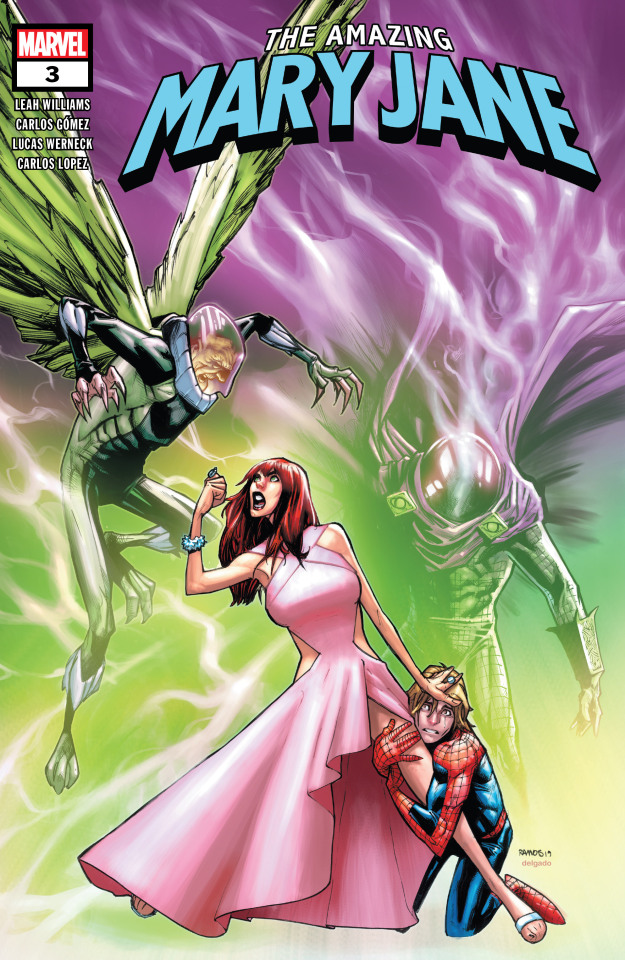
Previous Part
Next Part
Master Post
*pinches bridge of nose* Oh my God this is so bad
I was hoping last issue was a fluke but no. This issue also demands we dissect the recap page.
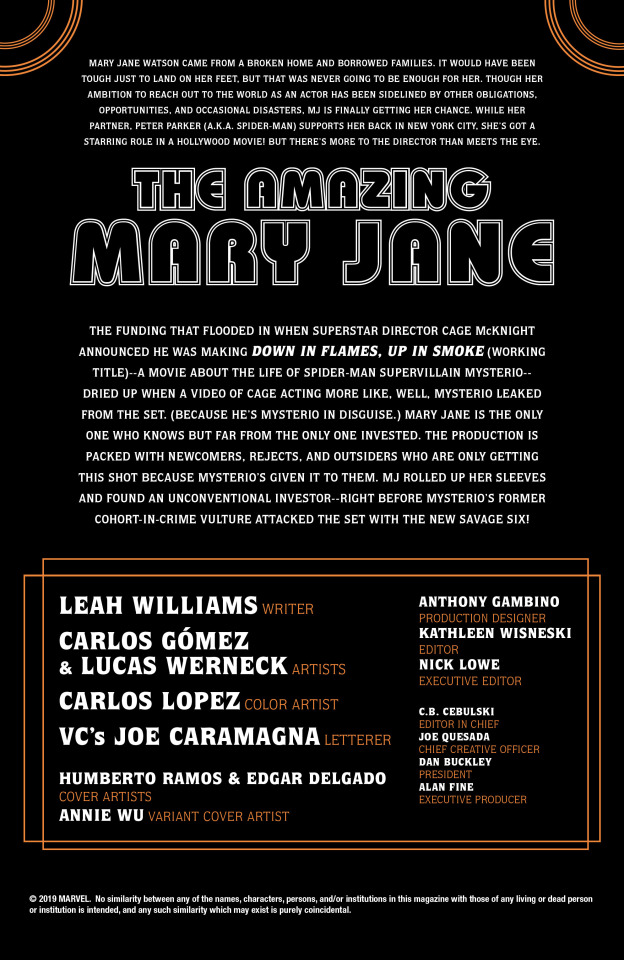
Let me just spell out for you all some fundamental dos and don’ts of a recap page.
DO please recap the events that happened in prior issues, or relevant context from any other issues.
DON’T introduce new information.
Last issue was guilty of that. And now so is this issue, arguably moreso.
This recap provides us with the working title for the Mysterio biopic. That’s right, the very first time we learn the name of the movie is on this recap page not in the actual story!
Want to hear another oh so slightly important DON’T to bear in mind?
DON’T contradict the story you are recapping!
The recap claims funding dried up when the footage of Beck abusing a crewmember leaked. That wasn’t the situation in issue #2. MJ speculated that that might be part of the reason. But the bigger reason was that Beck had sold the investors one one type of film and delivered another.
Let’s also consider this line from the recap.
…video of Cage acting more like, well, Mysterio…
So the recap (and by extension Williams, the editors and presumably MJ herself) acknowledge that Mysterio being abusive is standard practice for him. Good to know they are aware he’s a horrible dangerous person but are just ignoring that then.
The recap also confirms for us that MJ is definitely the only person who knows ‘McKnight’ is really Beck. So absolutely everyone on the crew are unwittingly putting themselves at risk, and MJ is just letting that happen. If they knew they might not want to work with him for one reason or another, but MJ and Beck are knowingly withholding that choice from them. It doesn’t matter that they are only getting this shot because of Beck’s charity, at least some of them would think twice if they were aware of the potential scandal they were working on.
The recap also contradicts last issue’s recap in regards to the staff of the movie. Last time it was staffed by ‘outsiders’ but now it’s ‘newcomers, rejects and outsiders’. Which is it? I’m not claiming this is irreconcilable or that big of a deal storywise but it’s another example of the incompetent craftsmanship on this title. Not to mention this recap again omits the fact that active villains are working on the film.
The recap also implies Mary Jane is ‘invested’ in the film. Let me get this out of the way now to save myself time later. Mary Jane wouldn’t be invested in this movie, at least not the way the story is depicting her as.
To a large extent this touches upon earlier instalments where I explained why MJ wouldn’t sympathise with Beck, why she wouldn’t regard him as a kindred spirit and why she wouldn’t value her career above the greater good.
Having said all that I don’t feel it’s necessary to dedicate a whole instalment to why MJ wouldn’t be invested in the movie. The idea that MJ would endanger herself and others for the sake of an artistic project she believed in or was interested in is fucking ridiculous.
The idea she’d be chummy with Mysterio is fucking ridiculous given their shared history and what she knows about him. But, just as a little reminder, here is Daredevil v2 #8, where MJ basically says Beck deserves no pity.

As we open up the story proper, Mallorie rescues a veteran actor (Sonny Diperna) cast as the Vulture. Specifically she rescues him from the Scorpion who trashes the set.

This scene has an admittedly funny meta-gag about Michael Keaton having played both Adrian Toomes in the MCU and Birdman in the eponymous movie.
Mallorie is also pretty cool here. Initially I was going to complain about how unlikely it is for there to be two capable and resourceful civilians in this story (MJ and Mallorie). However, in thinking about it, MJ didn’t become resourceful in the first place due to rare life circumstances. Therefore it’s perfectly reasonable that Mallorie be similarly resourceful in a crisis. Plus her job on set opens up the idea that she knows how to muddle through a crisis.
On the next two pages Vulture menaces the set and we are more formally introduced to his Savage Six. They consist of Vulture, Scorpion, Stegron, Tarantula (I don’t know which one), Rhino and King Cobra.
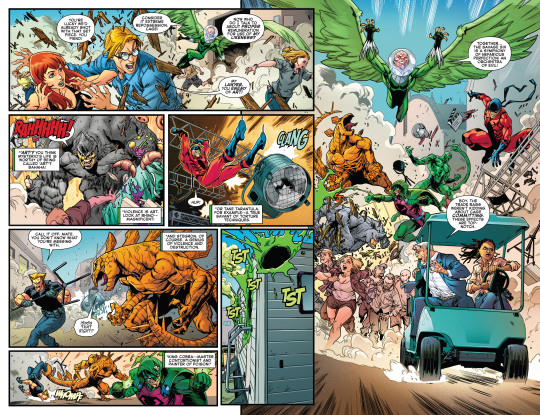
Whilst Williams characterization of Beck is generally great (albeit too sympathetic) the same can’t be said of Vulture. Making art or artistic vision a theme for this series (and Mysterio specifically) is perfectly invited by the premise of the story. However, it’s very ill fitting for a character like Vulture. Vulture is absolutely not defined by that theme whatsoever. He’s an inventor. He’s a grumpy, bitter old man. He’s someone who’s got a chip on his shoulder, out to prove that he isn’t passed his prime.
With that said, what the Hell is up with this dwelling upon ‘art’ in these two pages?
Fleeing the chaos, Diperna mistakes the villains as part of the film; a fact Mallorie goes along with. As Kangaroo (who’s basically the muscle on set) gets defeated, MJ and Beck try to escape. MJ insists they get the staff to safety which Beck agrees with, deciding to act as a diversion. MJ is concerned for his life, but Beck assures her it’ll be fine. Just then he’s dragged away by Scorpion.
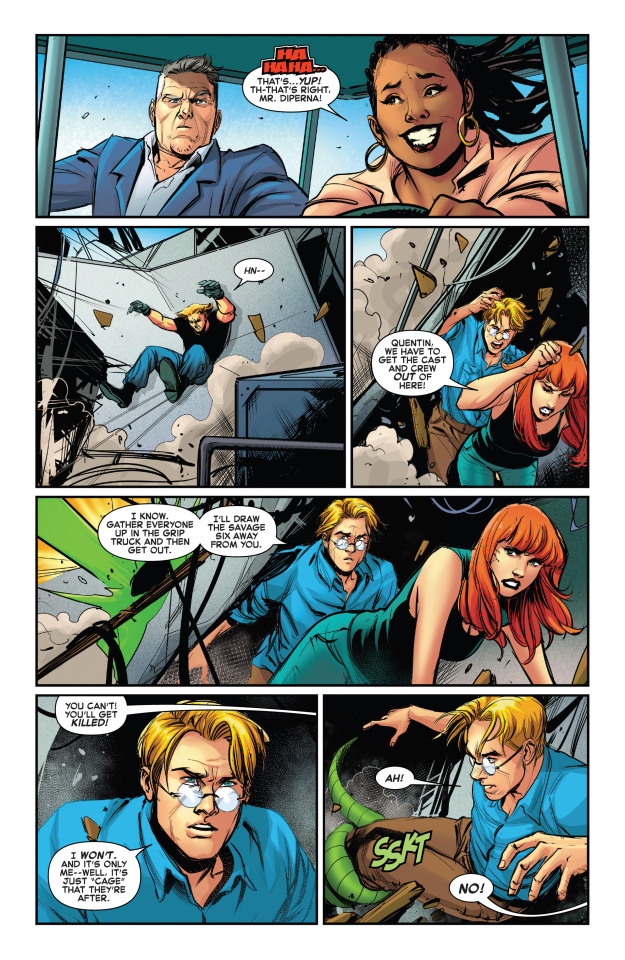
MJ seeks out Noah from last issue and drives his truck towards the Rhino.

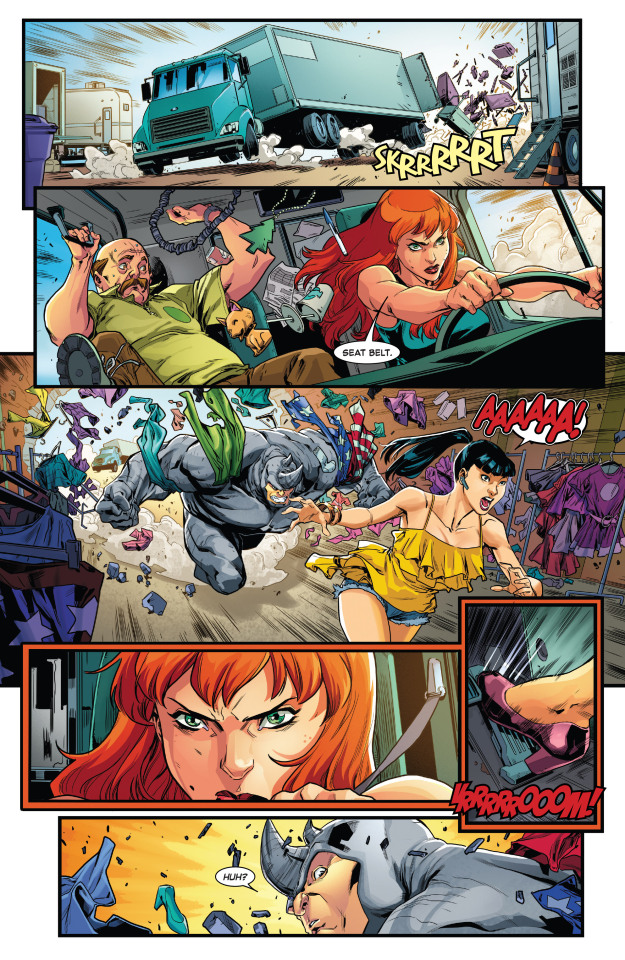
The art isn’t exactly clear on what she does next, but the end result is that she’s gathered up all the cast and crew into the truck. Meanwhile, Beck begins to engage the six by conjuring his trademark green smoke.
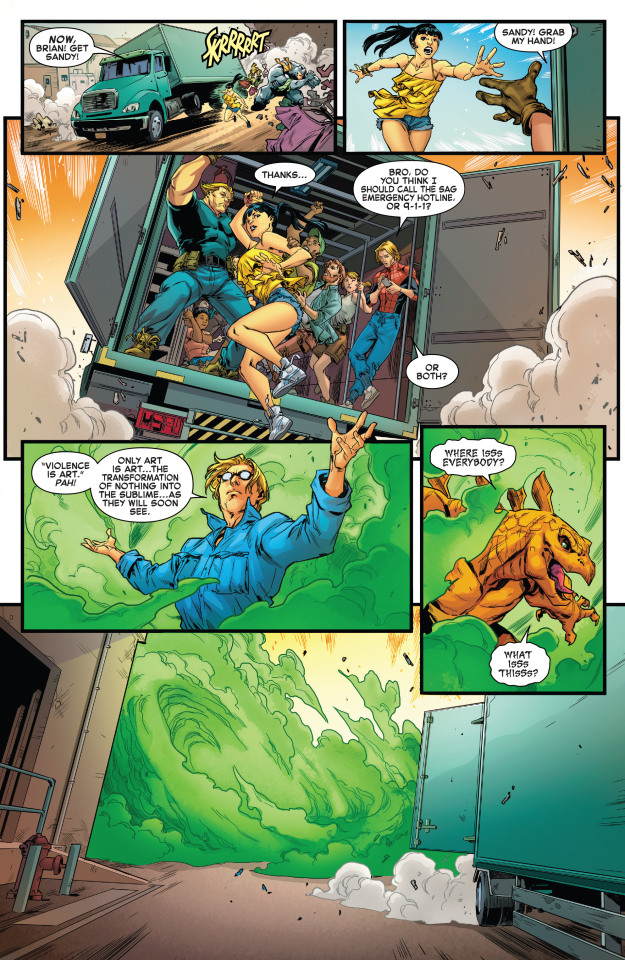
Mallorie and Diperna make it to the truck, with MJ lowering the ramp to allow them access. She is visibly concerned for Beck as they move out of sight of one another. The cast and crew for their part are star struck by Diperna. Diperna explains that he came out of retirement to play the Vulture as it was something different from the roles he was usually typecasted as. He elaborates that the movie has Hollywood on edge and that the elites do not want the film to succeed. He joined the cast to help them out a bit.
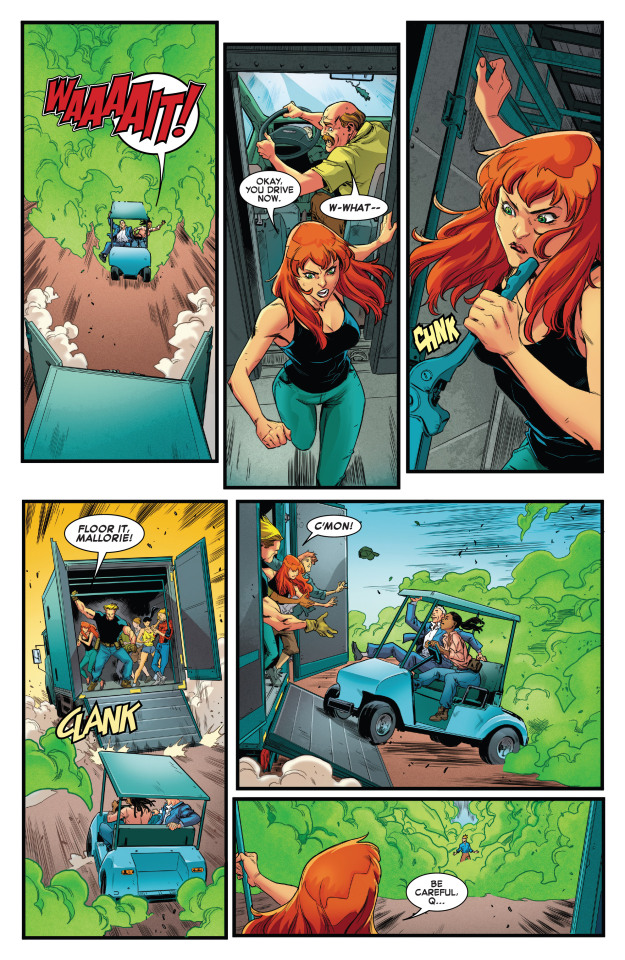
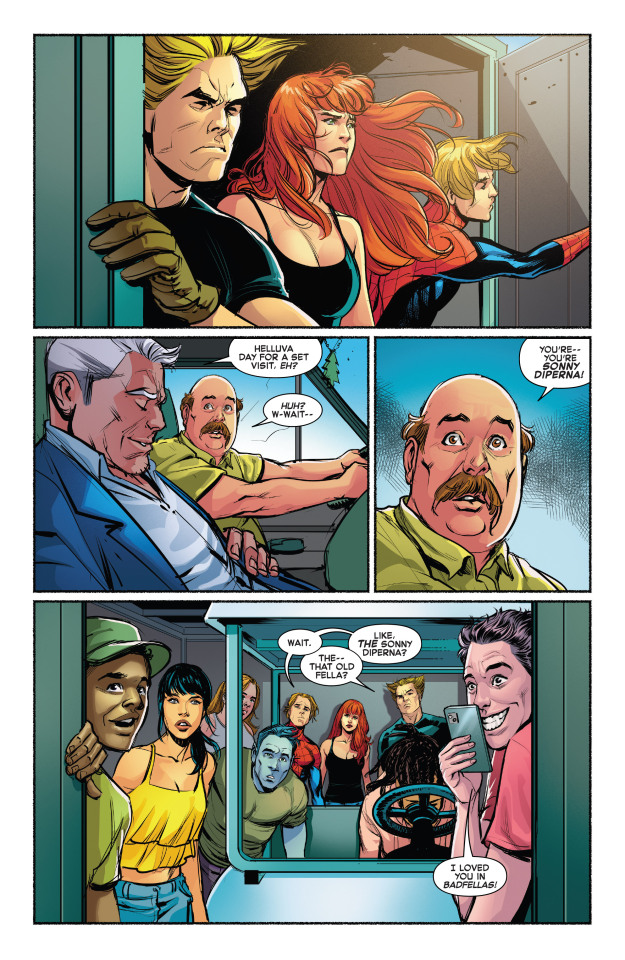
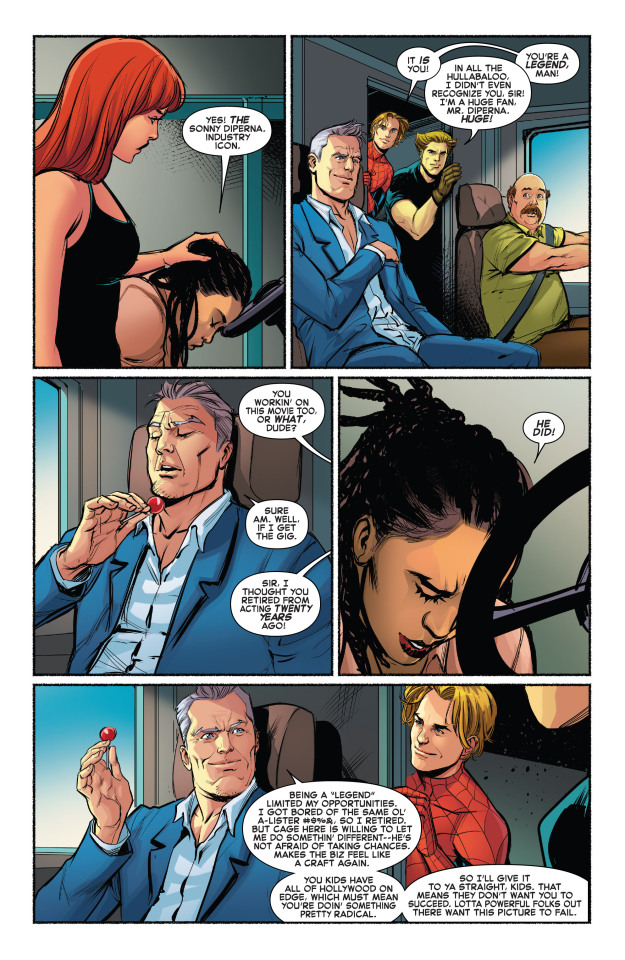
Elsewhere, Mysterio duels the Savage Six. He uses his illusions to trick them into believing they are in the desert. As they begin miles of marching, Vulture speculates McKnight is a double agent for A.I.M. When the illusion ends they find themselves at a national park, prompting Vulture to swear vengeance.
Much later MJ laughs at Beck’s trick complimenting his cleverness. However, the event has prompted several cast and crew to leave and delayed shooting even more. Thankfully Beck’s found a safe new location to film at.

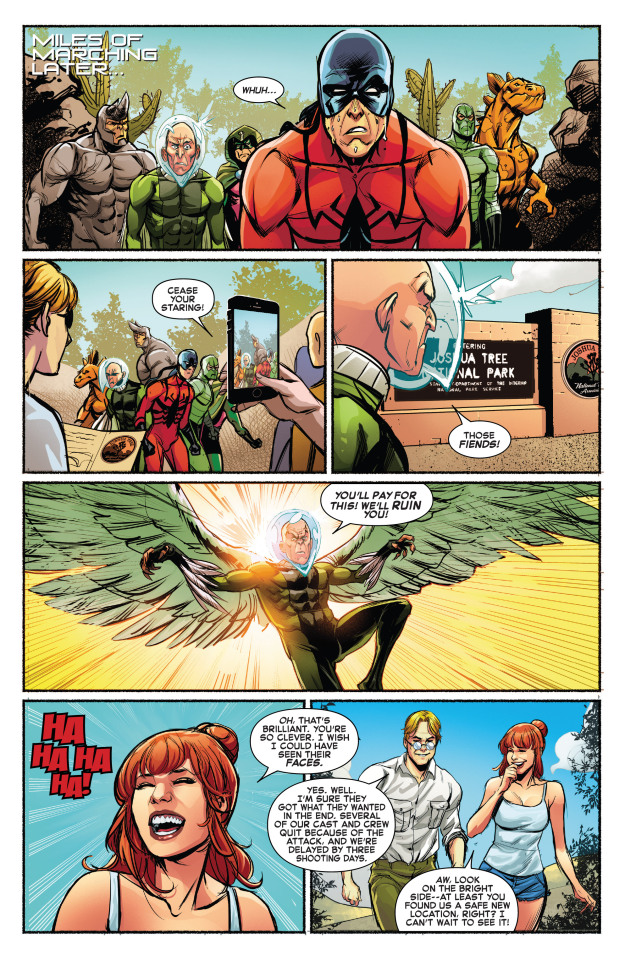
Sorry for that lengthy description. I just felt it was more efficient to get through that whole sequence and then break it down fully.
First of all, see all my prior comments about how bullshit it is for MJ to compliment, laugh at, be concerned for, or be sympathetic towards Beck. I also find Williams choice to frame him in a heroic, self-sacrificing light to be questionable. He is after all none of those things. Just the last issue the story called out the movie as a vanity project.
Additionally, this whole situation is exemplary of many of the points I made in parts 19-23. Here we have a major crisis with super villains on the rampage. Civilians and property are in jeopardy.
And Mary Jane’s abilities to help are limited. They are in fact incredibly reliant upon Mysterio covering her. Noticeably, he is the one actually fighting the Savage Six. MJ’s abilities to help are limited to shepherding and transporting people to safety. But she’s only able to do that with Mallorie’s help and the presence of a huge truck that was there purely by chance.
What If Beck wasn’t present, or worse, on the Six’s side? What if Mallorie hadn’t saved Diperna? What if there hadn’t been a truck? How would MJ have succeeded realistically? I’m not saying it’s impossible but her chances of survival were slim at best and would’ve been reliant upon finding other resources to exploit to her advantage.
Furthermore, the Knagaroo was injured in the fray. Maybe not seriously, but he was nevertheless injured and MJ was powerless to prevent that. He was lucky to have survived at all, now imagine if he was a normal security guard who had no experience fighting super powered type? How likely would he have been to live?
Now of course, the Six’s attack wasn’t exactly Mysterio’s fault. We could argue if Beck hadn’t endeavoured to make the film or omitted to include the Vulture the situation might’ve been avoided. However, this isn’t the first production in the Marvel universe to include ‘real’ super villains. Had the real Cage McKnight (or any director) made any movie featuring the Vulture at this time, it would’ve happened. In fact without MJ or Beck’s presence the cast and crew’s likely wouldn’t have fared as well.
Nevertheless, as far as MJ knows a similar situation could have occurred (or could still unfold) with beck and/or his criminal crew. Last issue she already saw Beck start a panic in the streets by throwing a tantrum. She doesn’t know all the crew so well as to guarantee they wouldn’t do anything nefarious. And in such a situation, her abilities to help would be extremely limited and situational, just like they were here. In fact if Beck has just explained to her how he single handily dealt with six super villains (who’re all stronger than him by the way) shouldn’t that spell out to MJ just how dangerous he is? That he could very easily ‘deal’ with her too if he wanted to and her chances of victory would be extremely slim?
Then we have the revelation that cast and crewmembers have left the project. The implication is that these crewmembers left because of the Six’s attack. Either they were hurt or more likely they were concerned about the risk. However, none of them were aware that they were already taking a big health/career risk by working under Mysterio himself; whilst he was stealing someone’s identity no less. MJ’s complicity in this deception is removing the agency of the cast and crew for no justifiable reason.
More problematically we don’t know if any of the crew who left were the active villains spoken of in issue #1. If they were then MJ has just allowed them to walk away without facing justice! And realistically given how they are fugitives and the film was a unique opportunity they are very probably going to go back to crime! But Mary Jane is laughing!
Now in the interests of fairness I should point out Beck did put himself at some risk for MJ and the others. This is one of the important factors that has led Peter to giving criminals a chance at redemption in the past. We looked at several of these back in part 10. However, noticeably most of those people weren’t as bad as Beck. They also hadn’t hurt Peter or his loved ones as personally the way Beck has from MJ’s point of view. There were also other extenuating factors going on that led to Peter giving them a shot. Often this entailed Peter knowing there was something or someone capable of reliably keeping the reforming criminals in check. Whether that was his own super human abilities or an official body monitoring them, the point is MJ hasn’t got anything like that in this situation.
Beck might’ve shown a glimmer of promise, but MJ is fully aware how villains like Venom and Sandman have displayed moments of self-sacrifice too. They’ve continued to do bad things in spite of that, or gone back on any promise they once showed. That doesn’t mean that Beck definitely would, but it’s a humongous gamble to take with no insurance.
And let’s remember what Beck was willing to sacrifice himself for? His cast and crew? No. His art. Look back at the page introducing the Six. Beck accuses them of being ‘Enemies of Art’.
Yes, the most generous interpretation is that Beck genuinely cares. But it’s also more than possible his care fro his cast and crew extends merely to their contributions to his vanity project.
On the next page we discover Beck’s new, safe location is something of a shithole.
Beck’s hired a new crew, but with everything that’s happened cuts will need to be made. MJ suggests they cut the romance scene with her character. Beck points out that it’s less screen time for MJ. MJ counters it doesn’t take away from the hero’s development and that it was always self-indulgent anyway. She follows up that they are making a biopic, not a fantasy film. Beck seems miffed at this point.

There is a fair bit to unpack here.
MJ is being self-sacrificing here, which is true to her character. She’s allowing her career opportunities to suffer in order for the project over all to succeed. This further hurts the argument that MJ is sticking around for the sake of her career.
But the context is confusing.
In ASM v5 #29 dialogue from the script was ripped straight from Webspinners #1-3.
This dialogue involved Beck talking to an old flame (Betsy Schneider), arguably the only woman he was ever in love with. She was noticeably not a super heroine, yet in the movie she was. I didn’t bother to bring that up before because, this being a vanity project, it’s not unbelievable that Beck would misrepresent his life inaccurately. ‘Look at me I got a sexy super hero for a girlfriend! Aren’t I cool!’.
MJ wouldn’t necessarily know the truth of Beck’s lover so I didn’t bring it up before. Here though, Williams is implying that she has sussed out that Beck was making that aspect up. At which point MJ should further realise the movie is an exercise in self-indulgence. She even says so in this scene.
More confusingly, in issue #1 Beck heavily implied to MJ that he was making this movie (and wanted her in it) largely because he felt he let Betsy down. That being the case, wouldn’t cutting out the romance undermine the point of the movie? Or at least undermine it from MJ’s POV? Honestly, that’s not that big of a deal though. Beck’s motivations for making the film have already been contradicted since issue #1 anyway; it’s already a goddam mess.
Furthermore, the scene specifically says romance ‘scene’, as int eh singular. Call me crazy but whenever there is a romance between a protagonist and a love interest in a film their romance isn’t confined to just the ONE scene. It’s usually a few scenes at least. In this case, MJ’s character exists in the story fundamentally to be Beck’s lover. She’s been given much more than that due to MJ’s suggestions in issue #1. But that was still the primary role she existed for. This means MJ’s role in the movie goes against the entire reason Beck included her. So why would he agree to that? Why would MJ suggest it if her investment hinges upon sympathy for Beck? She has basically taken Beck’s original intention for her character and gone from improving upon it to basically substituting all of his original intent for something else entirely.
She even calls its inclusion unrealistic. That could be a display of her trademark confidence (MJ is fully aware she is attractive) and/or a dig at Beck. Either way she’s tempting fate there. She already saw him throw a tantrum last issue and now she’s altered arguably the most important role in the movie to him and thrown shade at him over it. Real clever.
Additionally she refers to Beck’s role as the hero. This further contradicts issue #1’s assertions that the film was portraying Beck as a villain. It’s also rich for MJ to claim the romance should be cut as the film is a biopic. By that logic Beck shouldn’t be framed heroically, empathetically and the film should apologise for his acts of evil.
There is also a meta-argument to be made about Williams’ intentions with this page. It’s possible she’s critiquing the superfluous nature of so many romance stories in Hollywood films, arguably super hero films in particular. I don’t really have any praise or problems with that if it is the intent. Just thought I’d point it out.
As for the new crewmember…we’ll get to them later.
Over on the next page ‘McKnight’ tells Mallorie to give MJ a producer’s credit. Beck explains that the new location is an abandoned zoo, hence why it’s a shithole. He proceeds to introduce the new members of the crew.
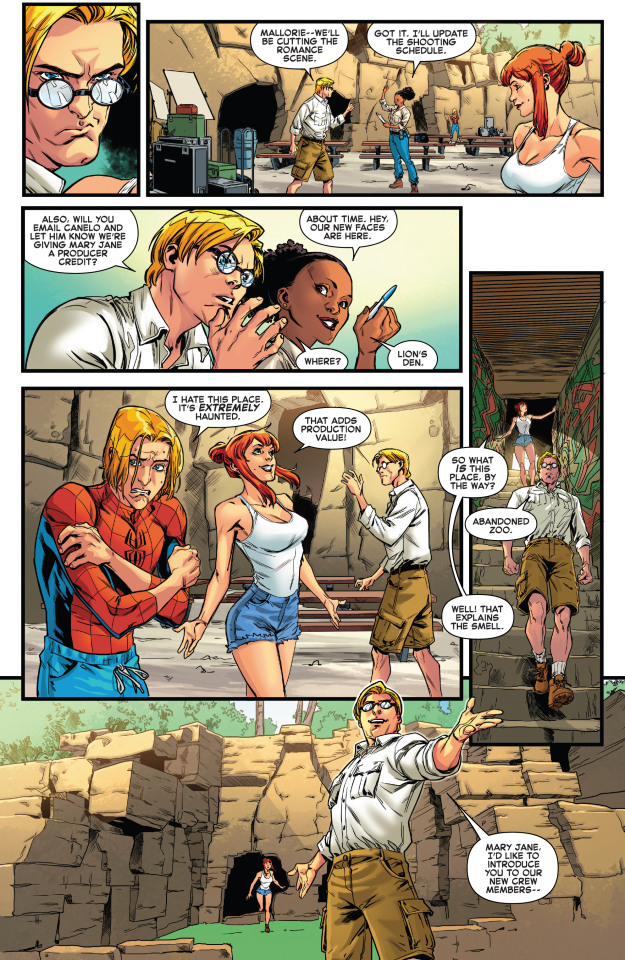
The only thing of note is Beck giving MJ a producer credit. This raised an eyebrow from me because it epitomizes so much of MJ’s role in the story thus far.
MJ’s most famous profession is an an actress. In the majority of adaptations that’s her job. It was part of how she was introduced to us in ASM #43. It’s one of the things that thematically connects her to Spider-Man. It’s also through her renewed interest in acting that we got this story.
In fact MJ gave a heartfelt monologue specifically about acting in ASM v5 #25 and it was this monologue that led to her job on the biopic.
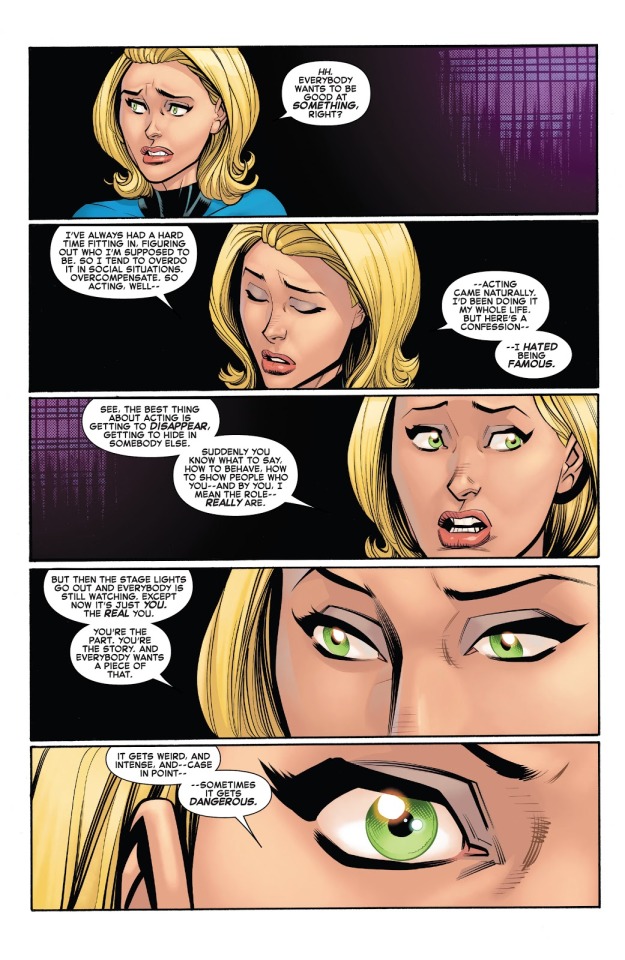
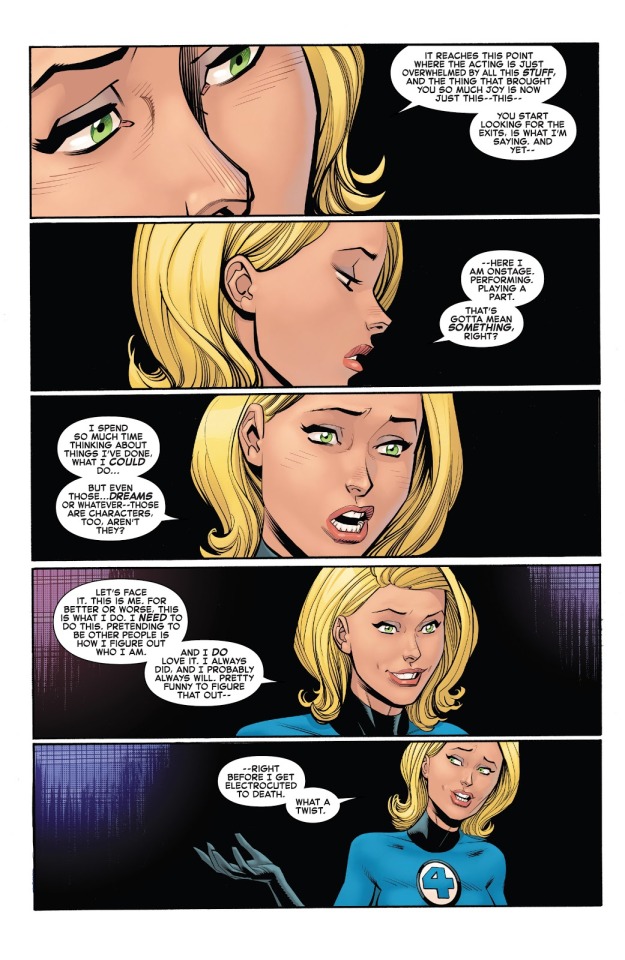
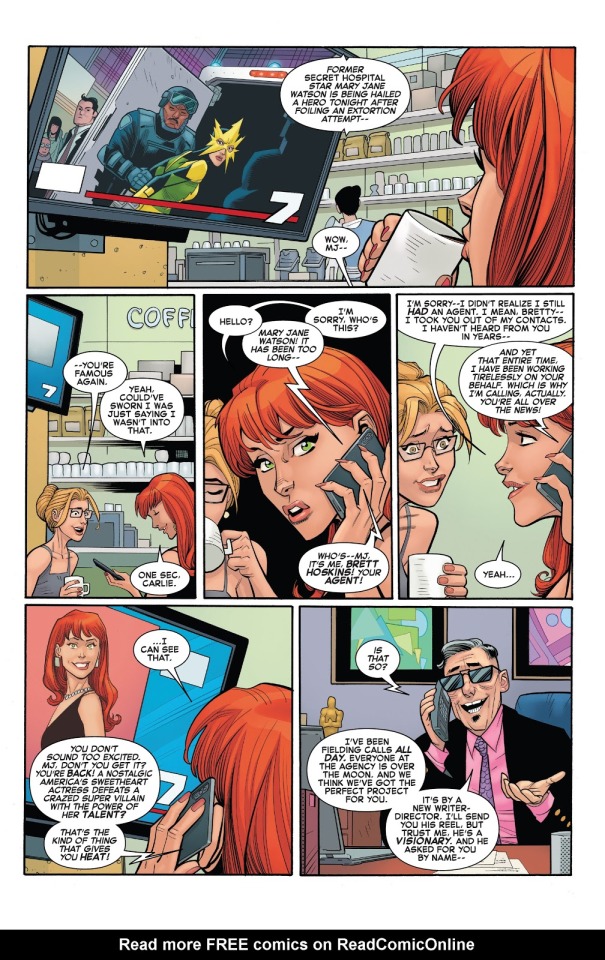
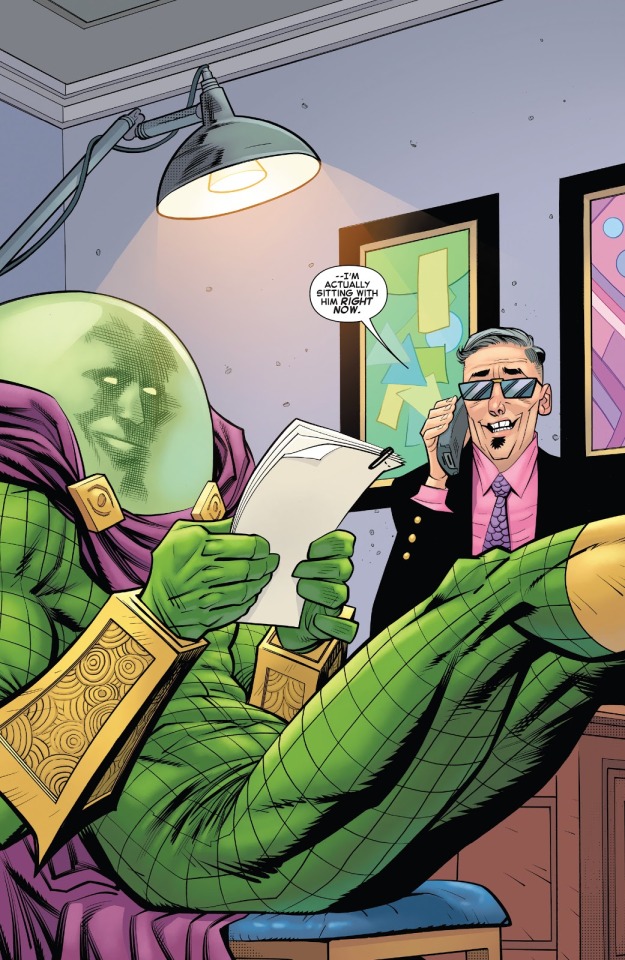
And yet in this story Mary Jane has spent very little time acting. The story itself has ruminated very little about her role as an actress or depicted her acting at all. Mysterio has been acting far more than Mary Jane has.
MJ’s main role thus far in the story has been as Beck’s right hand, as his producer.
Isn’t that rather problematic? That wasn’t the story as advertised in Spencer’s ASm run, nor even in the initial build up to AMJ’s release. It also goes against the themes that have traditionally defined Mary Jane, especially within the context of her actually working on a movie.
I have a tinfoil hat idea as to why this might be the case though. Here is an excerpt from an interview Williams gave prior to issue #1’s release:
It's set in Hollywood and it's a film production, and my work background is actually in film production. I lived in LA for a little while. So drawing upon the full arsenal of my Hollywood hot mess stories of what goes on on film sets, that has been an absolute delight. Because then I can also demonstrate how MJ is able to think on her feet and be like, okay, well let's not do the bad thing. Instead, let's be smart about it. Very cathartic, again. So cathartic.
-From Bleeding Cool
I’m not going to presume working in ‘film production’ means Williams was a producer per se. I’ve also been unable to find any evidence that she was a credited producer nor that she worked as an actress.
But it seems to me Williams in drawing upon her personal experiences is skewing MJ more towards the jobs she personally did. In other words Williams is writing MJ as closer to a producer than an actress. It comes across very much like Spencer/the editors handed her a certain premise and she then terra formed it into what she wanted to do, rather than what the direction he set up implied.
That is all total speculation on my part. I have no hard proof at all to corroborate that.
But if that is what’s going on, then I find it kinda shitty. It’s not exactly what the role asked of her as a writer and more poignantly it’s not what MJ’s history invites either. It’s not that MJ couldn’t be a decent producer it’s just that that isn’t where the thematic resonance for her character lies. At least, not within the context of making a movie.
Let’s leave it there for now and continue next time.
Previous Part
Next Part
Master Post
#Amazing Mary Jane#Leah Williams#Mysterio#Quentin Beck#The Vulture#Adrian Toomes#Spider-Man#mjwatsonedit#mary jane watson#Mary Jane Watson Parker#MJ Watson#Carlos Gomez#Vulture#Mac Gargan#The Scorpion#Scorpion#Stegron#Rhino#The Rhino#Alex O'Hirn#Peter Parker
11 notes
·
View notes
Text
Ghost of Tsushima Ending Explained
https://ift.tt/30n9aM4
This Ghost of Tsushima article contains spoilers.
Ghost of Tsushima is as epic as the classic Akira Kurosawa movies that inspired it. And in the spirit of those movies, Jin Sakai’s long journey to free his homeland from the Khotun Khan and his Mongol army concludes in brutal fashion.
Main protagonist Jin goes through a lot, both internally and externally, on his journey, while wrestling with the traditional, samurai notion of “honor,” whether or not it’s worth dying for, and what honor is worth when innocent lives are on the line. Fittingly, the game’s finale sees Jin come face to face with two opponents who are ultimate representations of honor and dishonor.
Needless to say, there’s plenty to unpack in Ghost of Tsushima‘s final moments. I’m going to delve into the conclusion of Jin’s tale in-depth, exploring the complexities of his relationships and the repercussions of the tough decisions he’s faced with.
What does killing Khotun Khan really mean for Jin?
In the final battle scene of the main story, Jin and his allies Yuna, Sensei Ishikawa, Norio, Masako, and Kenji storm Khotun Khan and his army at Port Izumi, blowing the unsuspecting Mongols to bits with explosives and slashing what’s left of them to pieces, clearing a path for Jin to finally finish the one-on-one duel he and the Khan had at the beginning of the game.
Of course, the fight doesn’t wind up being a fair one because Khotun has no honor. Jin fights Khotun one-on-one for a while, but then the Khan retreats to his ship, where Jin must take the Mongol leader down as his armed cronies rain swords, spears, and fire arrows down on the Ghost’s head. When Jin finally defeats Khotun, the dying Mongol utters the words, “Kill me and another will come. We will be remembered.”
To this, Jin replies, “No. You will be forgotten,” before slicing Khotun’s head off of his gigantic shoulders. Killing the Khan doesn’t end the invasion — there are still Mongol encampments strewn all over Tsushima. But I believe Jin’s victory symbolizes something much deeper for him personally.
Throughout his journey, Jin has struggled with the nature of honor. It’s virtuous to fight enemies head-on, in a fair fight. But what if your enemy refuses to fight fair? Is it worth risking the lives of your people in the name of honor, or is it justifiable to use the art of deception to gain an unfair advantage against an enemy as unscrupulous as the Mongols?
In the context of Jin’s story, Khotun Khan represents what happens when a warrior succumbs completely to the allure of dishonor, or “the way of the Ghost.” When Jin tells the Khan he will be forgotten, he knows that because he’s taken up the ways of the Ghost himself. Jin will be forgotten, too. All of Jin’s sacrifices to save Tsushima will not be attributed to him or clan Sakai, but to the Ghost.
What is the significance of the peasant and his cart?
Shortly after Jin and Lord Shimura meet at their old sparring circle in Omi Village, they happen upon a peasant whose cart is stuck in the mud. He tells them he’s headed North to join the Ghost’s army and they help him get his cart back on dry ground. Lord Shimura even wishes him well, telling him to avoid Mongols.
Jin has no idea what the peasant is talking about — he hasn’t started an army. But Lord Shimura enlightens him, explaining that the figure known as Ghost has now taken on a life of its own. Jin’s actions as the Ghost — particularly his open defiance of Lord Shimura’s orders when they retook Castle Shimura from the Mongols — have encouraged the people of Tsushima to question their leaders in a way that dismantles the foundation of tradition that samurai and the shogun were built on. Essentially, Jin has sparked a revolution.
There’s a lot of foreshadowing going on here. As we later learn, Lord Shimura is leading Jin to a duel to the death, but as they help the peasant and discuss the repercussions of the manner in which Jin has chosen to fight the Mongols, it’s clear that Shimura harbors no anger toward his nephew. He still loves him, but he’s disappointed and mourns what they once had. They were meant to be father and son, but the fact of the matter is, Jin has undermined everything Shimura worked his life to defend and uphold, and what’s worse, he’s now inspired the people of Tsushima to follow suit.
Why does Lord Shimura fight Jin to the death?
At the Sakai family cemetery, Lord Shimura reveals to Jin that he’s been tasked by the shogun, who have branded Jin a traitor, to kill him. Jin believes that he’s inspired people to stand up for themselves, but in Lord Shimura’s eyes, there is only one way to lead one’s life: with honor. And because Jin has chosen to use dishonorable tactics to defend Tsushima, he must pay for his transgressions.
What this all boils down to is that Lord Shimura is so unshakably committed to honor and samurai code that he intends to kill his would-be adopted son in the name of it. He’s an honorable samurai, and he refuses to compromise. “You have no honor,” he scolds. “And you are a slave to it,” Jin retorts. This is the inevitable impasse that these two warriors, the last samurai of Tsushima, have arrived at.
There’s a generational aspect to this finale that resonates with the current sociopolitical state of the world as well. Lord Shimura is devoted to tradition to an almost fanatical extent. He represents an older generation who are in power and whose stubbornness and refusal to listen to reason in times of crisis cause them to risk innocent lives in the name of upholding the status quo and protecting archaic notions of right and wrong. Sound familiar?
Read more
Games
Ghost of Tsushima Directors Explain Akira Kurosawa’s Influence
By Matthew Byrd
Games
Is Ghost of Tsushima Coming to PS5?
By John Saavedra
Jin, of course, represents a younger generation that dares to challenge old ideas and who aren’t afraid to rail against tradition if it means finding a better way to protect their people. They aren’t afraid to call out their elders on their bullshit and take a progressive, evolved approach to leadership.
Remember: Despite Ghost of Tsushima being set in ancient Japan, Sucker Punch is an American developer. It likely isn’t a coincidence that Jin and Lord Shimura’s eternal debate over tradition vs. progressivism bears a resemblance to the elevated generational conflict that has gripped the US in recent years.
Are Lord Shimura and Jin father and son?
Despite Jin and Shimura’s irreconcilable differences, there’s one thing that’s crystal clear when watching them ride on their horses together through Omi Village: they still love each other. This is the tragedy at the center of the story. Because these men have chosen diverging paths, there is no longer a way for them to coexist at all. And yet, they are family and they care for each other deeply. It’s a paradoxical situation, but Shimura had tried his best to bring Jin back to his side of the fence.
Earlier in the story, Lord Shimura lovingly reveals to Jin that he’s publicly announced his intention to adopt Jin as his son, adding that he demands Jin stop using deceptive tactics in battle and face his enemies head-on (no matter the cost). But then Jin poisons a gaggle of Mongols at Castle Shimura, a spectacularly dishonorable display that saves the lives of countless Tsushima denizens and thoroughly embarrasses Lord Shimura in front of his new shogun buddies.
This act of defiance forces a rift between Jin and Shimura that seems insurmountable, and they never make the adoption official. But in their samurai showdown (sorry, had to) at the Sakai cemetery, they seem to still be referring to each other in familial terms, almost unmistakably like a father and son would. Actually, if you die during the boss fight, Shimura actually calls Jin “son” before sticking his katana in his spine. Brutal.
Technically, Shimura and Jin are not father and son by the end of the story. They’ve chosen separate paths and they will never walk side by side again. But at that moment, in their hearts, they are father and son through and through (this is reinforced even further depending on whether you choose to let Shimura live or not when you defeat him — more on that shortly). “Our final day together,” Shimura says moments before they cross swords. “It is beautiful.”
What is the meaning of the final haiku?
Before Jin and Shimura’s epic fight to the death, they each write down the final words of their respective clans in the form of haikus. As in all of the other haiku moments of respite in the game, you’re given three options to choose from for each of the three lines of the poem. The words are profound encapsulations of their fraught relationship over the years.
Line 1 options:
Eyes that saw my pain
Hands that shaped the world
Strength in every step
Line 2 options:
A fate neither of us want
Destiny divides our souls
A bond broken forever Line 3 options: I fight without hope This is where we part Will death redeem us? The most intriguing option of all is, “Will death redeem us?” I believe Jin is being skeptical here, asking himself whether killing each other is the only course of action, as the shogun suggest, or if it’s all just a pointless, empty display of “honor” in the most antiquated sense. What’s the point of them fighting each other? Is it the right thing to do? Jin doesn’t think so. Essentially, the haiku just reinforces how insanely depressing the characters’ predicament is. There’s a finality to Jin’s words, and the most heart-wrenching thing about the poem is that he has chosen to make the final words of the Sakai family a miserable breakup letter to/about his uncle, who isn’t even a Sakai!
What happens if you choose to spare Lord Shimura?
Once Lord Shimura is defeated, he requests that you grant him a warrior’s death. “Honor me,” he pleads. You are presented with a choice: You can either spare him, essentially spitting in the face of the ideals and philosophies Shimura dedicated his life to, or you can grant his wish and let him die on his own terms.
If you choose to spare his life, Jin stands tall above his beaten uncle and refuses to kill him. “I have no honor,” he says. “But I will not kill my family.” Shimura, heartbroken, tells his nephew that, “The Ghost will be hunted for the rest of his days,” to which Jin replies, “I know.”
Jin choosing to spare his uncle is the ultimate act of defiance. In his mind, he’s eschewing tradition and choosing to lead his life not by blindly following old traditions, but by carving his own path and thinking for himself. At the same time, he knows that his uncle doesn’t see it that way, and he knows quite well that he’s just denied his mentor his dying wish. This is heavy, heavy stuff.
Jin then puts on the Ghost mask and walks away. He knows that his defiance won’t come without a price. He’s giving up his life as a samurai and his relationship with his uncle to fight for his people in the way he sees fit. It’s a sacrifice he’s willing to make.
What happens if you kill Lord Shimura?
This is where things get really Shakespearean. If you choose to kill Shimura, Jin makes him a promise: “I will make sure you are remembered as a great warrior, a wise leader, and a father.” Shimura is appreciative. “Thank you, my son,” he says, as if indicating that Jin has won back his respect. “Find me in the next life.”
It almost feels like an act of mercy for Jin to kill his uncle. Yearning for a warrior’s death isn’t a foreign concept for Jin — he often talks about the guilt he harbors for surviving the Mongol invasion at Komoda Beach when his samurai brethren didn’t. While his values may no longer align with his uncle’s, to let his one-time mentor leave the earth on his own terms is like a parting gift, a sign of utmost respect for a warrior who was uncompromising in his beliefs.
Ghost of Tsushima is out now on PlayStation 4.
The post Ghost of Tsushima Ending Explained appeared first on Den of Geek.
from Den of Geek https://ift.tt/3fRUdZi
2 notes
·
View notes
Video
youtube
About #Menswear Selected By Guaizine:
Digital Fashion Week - A One Time Only Event?
Milan S/S 21 Menswear @showstudio Round-Up Discussion
Just a few @guaizine reflections about some of the opinions from the experts panel:
..."we are not going to get into a pandemic again"... well, I would not be so sure about it, and I think that is the main reason why we should get digital fashion weeks seriously and realize about the potential they have as a format if we manage to take advantage of it in the proper technical way. Those designers still presenting traditional runway shows have different audiences, broader ones, in comparison with smaller brands where the designer as a person is not as important as the product itself. For these smaller brands digital fashion weeks become crucial, as they represent the only -effective- way to reach a client; direct one or an eventual retailer.
..."give the youth more control of the creation"... this is a very good point of view, and I am pretty sure that many of the people involved in fashion for years, -for generations actually - like happens in many of the houses that take part on the MFW for example, had or still does have that great idea of bringing new blood to their business in mind too, but I am pretty sure also that such a thing won't ever happen if that “old” generation do not effectively see that the new one has the proper tools to make it work.
..."Brands are forced to bring their narratives to people and audiences"... Yes! that is right and that suppose to be the right way to approach the digital fashion week from a brand point of view, that is why I was surprised about not hearing about brands like MSGM or Zegna XXX, that having a quite sharp knowledge of their audiences manage to arrive directly to the core of it with a couple of beautiful presentations undoubtedly effective, taking a few steps away for the storytelling and focusing way more on the product itself, a product that seems to be made for their very specific buyers, and not focused at all on trying to generate trends during the next season. Playing safe is always a valid way of being part of the game.
Another interesting point of view is the budgets brands have to put digital shows online, and is obvious that a bigger budget gives you the potential to do something better in theory but this is not always the case and this is the perfect opportunity to bring the Magliano presentation to the discussion, a low budget presentation with an original collection presented is a creative way, nothing was left behind, and everything works as a perfectly executed puzzle. The video is simply a video art piece, that gives to a group or fashion insiders with an unique point of view the task of sending a message to an audience they know well so they manage to address them exactly what they are expecting from the brand, going even further away by pushing forward the brand appealing with content that to me is interesting to look at also to people who is not actually interested in fashion.
..."I really didn't watch a lot of the films and stuff...because they are so much content to sort of digest"... and? so? What do you think editors do then during fashion week? How can someone build some criteria to later go and write a piece to be posted or published if it is not by watching in this case, or attending in person to every single show in each city season after season? How can you give an opinion about a fashion week by only looking to a few instagram feeds of two or three brands? would that be the proper way to approach a panel discussion?
About Philipp Plein, Pierre was quite clever about going further instead of giving it time to be discussed. I have the feeling that the main reason why we still listen about him and his "work" during every fashion week is because with plenty of resources you manage to survive even if people only talk about you to criticize what you do. Maybe a bit less attention will give him the chance to reflect on his strategy and realize that maybe he has a market -obviously he does have one- but fashion weeks are not the kind of platform his brand needs and that huge budget can be invested on design or marketing.
About Etro doing a physical fashion show instead of a digital one in a city that has been suffering so much during the last months, I think is a topic very difficult to talk about especially if you are out of the social, economical and even political context of it. So I will leave to the brand itself and their PR team to deal with it, but also will avoid giving my free opinion about it on social media because saying that the event was inappropriate because I saw people not wearing masks for example is not only superficial but shows a huge lack of understanding of the context of the industry of fashion in the country, of the circumstances of the city today and so many other topics that goes beyond fashion. So saving the social media hubs our opinions about it I guess is the right attitude towards an issue we all know so little so far. Let's focus on fashion guys, please.
..."The people who were invited to Etro...most of them were white"... how can we be surprised about this in 2020?, there is not much black people involved in fashion, it is been like that for decades, so for me the element of surprise has no place at all in this discussion, what should be the brand doing instead? Inviting a bunch of random people just to make the show look diverse? I think the problem we need to face here once again is the lack of diversity in people involved in the whole industry and not in a particular fashion show that happens to take place immediately after the world has been facing weeks of protests that fight racism. Ironically seem to me like is way more honest a show like that, than the attitude that the most of the brands adopted for digital fashion week trying, desperately to look "inclusive": Being "inclusive" in fashion in 2020 according to digital fashion weeks, from Russia to Paris is "to exclude", Yes, exclude automatically from any fashion presentation or show any blonde model, as simple as that, Go for it and you instantly become "inclusive". Sounds exactly like a few years ago when we saw in the industry suddenly loads of oriental models to reach runways, presentations, and magazines after the fashion insiders finally realized that the oriental market was exploding and greeting western fashion and lifestyle as never before.
About the @gucci presentation and "...who would wear that"... is funny that after years of Alessandro Michele, a panel with plenty of stylists think that way about the brand and seems not to have done the exercise of to look at the clothes produced by the brand and designed by the designer and his team, properly, closely and separately. They all seem to stop instead at the styled looks they get from a magazine, or sadly once again, from the brand's instagram feed...
Let's move on..."There are a lot of brands struggling to survive, struggling to sell"... I agree, that is not a secret to anyone these days, But ironically you only had time to "watch and digest" two, maybe three digital fashion shows and they were of the biggest brands, so? What is the point here? won't those small brands be struggling less if we all will be talking more about them? showcasing them more on our websites and YouTube videos? "watching and digesting" more of their design and ideas? Don't you all guys think that would be a more fair approach to it, and without a single doubt an easy and effective way to "help" them?
..."Milan is always a step behind Paris"... please, let's be careful about this kind of opinion because we risk to look like people that see and live fashion -once again- from and around Instagram and Tik tok. The only reason why Paris and Milan are different is because the brands they showcase are different between them, different because they have different audiences, different markets, different targets, those factors make the difference and are not the trends they generate or not after the runway shows the relevant matter on this issue.
About Versace, the approach I agree was quite good, very much attached to the times. But I still have the feeling, even a few days after, that they missed a huge opportunity to make something great! They have everything that they need to make a video successful, but the director seems to be behind on the timing of the scenes, and rhythm was the big absent on the film, the whole final product seems lacking energy and action, which seems to be difficult not to be able to reach with such a vivrant tune, an stunning dancer, and good clothes - either you like the brand or not- at the end the whole looked more like a music video and not as a fashion presentation. With probably a huge budget you would expect a pretty much perfect piece of content, especially if in the past, smaller brands like Grace Wales Bonner, did stunning pieces like Practice, directed by Harley Weir and Grace herself and Devonté Hynes as a collaborator, demonstrating that is not money to make the different in this cases but talent mixed and balanced in the right way is.
The collection was presented under the title of "flash" because it was a "see now, buy SOON" collection and not a "See now, buy now" since as you mentioned it was not very successful at the end a few years ago. Keeping on Versace, I agree Gianni Versace was one of the main designers of the 90's but saying today that the brand needs to be given "expertise, fabric development and technical design" sounds to me a bit irresponsable. If you want "something a little bit new" I suggest you once again to look and focus on NEW brands, If we like -or not- brands like Versace is because they manage to keep a concept during their history and they try their best to present it in a different way season after season; sometimes they reach better results than others, ( becoming a "miss more than a hit" ;-P ) but at least there is a constant attempt on going beyond fashion and transforming those ideas more into a lifestyle for the people that likes, follows, and more importantly buy the brand products.
Moving into the JW Anderson presentation I heard ..."A designer explaining the meaning behind it...we do not get that from the designer mouth anymore"... come on, that is what designers do to press right before every single fashion show is about to start, and they do it once again to press and buyers after the show ends, is part of the fashion protocole, it is been happening for years, decades, so you will get that from "designers in the future" still, there is nothing to worry about.
A final word goes to Pierre A. who I talked to very quickly on Twitter to express my feelings about this round up discussion and he mention that "a live panel is not an easy exercise (specially on Zoom)" and of course underlining that it was his first time doing it, but from my very personal point of view you managed very well, in this cases one of the most important things to keep in mind is to give space to your guests and you definitely mastered that bit! Very well done! <3
1 note
·
View note
Text
MYP Magazine - Of Time And Truth.
[Original interview here.]
22/07/2019
Interview by Jonas Meyer. Photos by Steven Ludtke
[I skipped the introduction and went straight for the interview]

Jonas:
When the first season of “Dark” was released in December 2017, viewers and critics alike have literally fallen over their enthusiasm. So far, many had not expected such quality from a German production, especially in terms of dramaturgy and visuality. How did you, as a Netflix consumer, experience the series start then?
Louis:
Luckily I’ve been able to enjoy the series as a relatively normal, objective viewer - and that’s true of the current season two. In “Dark” there are several roles and plot-lines, in which my character Jonas does not take part and which I accordingly did not know about from the shooting. During the shoot, I tried anyway to push aside all the other plot-lines and focus only on Jonas Kahnwald. Otherwise, I would probably have gotten pretty confused because the content of the series is so complex.
Jonas:
What is the difference between the current season two and the first one?
Louis:
In Season 1, it’s all about something that happens individually to each character which they have to deal with. In the second season, these characters are much more active, especially Jonas. At the very beginning of the series he is still very passive and in the course of the episodes he has to learn how to handle the issues himself. In the second season, he already knows who he is, what he means and what he needs to do to achieve his goals - and of course, what he has to sacrifice. But all the other characters learn, too, overall, the knowledge of each character acquires in the course of the second season is much larger. In addition, I would say that this second season is also more emotional. Now much more information will be passed on to others which changes their view of the world.

Jonas:
On the platform kino.de there is an episode guide to the first season, in which it is said that a single viewing of the series is not enough to recognize all the contexts and hints: “Often, a short distraction like reaching out to take drink or a look at the clock is enough to miss an important detail." Do you see it the same way?
Louis:
The series is definitely complex, I agree. And with so much information to be conveyed in Season 2 to drive the story forward, this second season may be even more complex than the first one. Jantje Friese and Baran bo Odar have always emphasized that with "Dark” they wanted to create a series that challenged viewers in a certain way. By the way, that did not happen until then in Germany - here one tends to play it safe. After the release of the first season, funnily enough, there were critics on the one hand who said that the series was too complicated. And at the same time there were critics on the other side who complained that we were guiding the audience by the hand way too much.
Jonas:
How did you deal with the high complexity, which is created solely within the character Jonas Kahnwald? Is there always an overview, even if you concentrate only on your own narrative thread?
Louis:
Of course we all lost the thread every now and then. But thank God there is Jantje, who has the complete perspective. She knows down to the last detail how, where, what, and when something happens. During the shooting for the second season, we also had a Script Supervisor, to whom you could always turn. In addition, there were special screens on the set, where you could play the entire first season - in the event that you wanted to look, which specific point refers to a scene for which one is just in front of the camera.

Jonas: Lars Montag, director of the Netflix series “How To Sell Drugs Online (Fast)”, revealed to us in an interview recently that he has the feeling that since Fassbinder there is actually no German narrative anymore. He said: “All are just trying to imitate Hollywood in any way.” Do you think it requires a special German narrative style - just as the Scandinavians, French or English people attributed to their very own cinematic narrative style?
Louis:
Definitely, no. I think we live in times when everyone is trying to make something special. This alone starts up more and more narrative styles. This can be observed even among the Scandinavians, who are said to have a particularly strong stereotype in imagery and narrative style. The reason for this development is that we all talk more and more international - but that does not explicitly mean that we are more Hollywood-oriented. For me, telling an international story means that we can address viewers across countries by means of certain narrative styles and therefore do not have to reduce ourselves to our local schemes.
Of course, it still needs different narrative in film - but not to emphasize the national location, but to be able to address the most diverse types of spectators. Quite apart from that, there is not one big secret recipe of the Hollywood narrative that you have to use to reach out to people. Rather, I believe that it is much easier today to break out of this Hollywood compulsion - simply because the audience has become much more diverse.
Jonas:
The trailer of the second “Dark” opens with a gloomy, post-apocalyptic landscape in which a destroyed nuclear power plant can be seen. Is it not strange how realistic and quite imaginable such fictional images are when viewed in the context of the current social debate about climate change and impending environmental catastrophes?
Louis:
When talking about the future, there are two main scenarios that seem possible: one is an extremely modern and thriving science-fiction world of flying cars, where everything flashes and shines. The other is just the opposite: a dark scenario in which everything is destroyed - because we humans have destroyed ourselves. In this scenario, nature slowly regains the upper hand and runs us down. With “Dark 2” there was not necessarily the intention to create parallels to this second possible scenario. But it is actually noticeable that these pictures do not seem so unrealistic in this day and age.
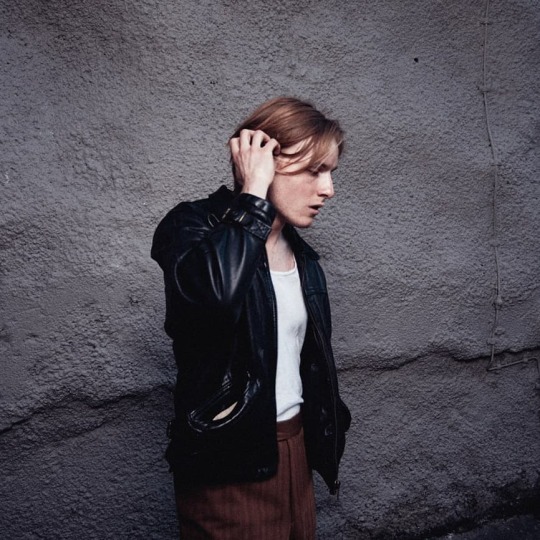
Jonas:
You recently appeared in the Arte short film series “Couples” with Dutch actress Hannah Hoekstra. You play a young couple who discusses whether it is appropriate to paint the German flag on one’s face, such as at a game of the national team. He gets mad about it, she does not understand his problem. How do you personally look at this country at the moment?
Louis:
With shame and concern because the most important and threatening topic in the world - climate change - is not taken seriously. There seems to be a kind of change of heart, which is also expressed by the fact that the Greens temporarily lead in the polls. Nevertheless, I always feel stifled when I realize how climate goals are ignored and Germany - which has a certain role model function - fucks it up. I think that’s really sad. I sincerely hope that this green trend will not be short-lived and will continue because we simply have to make sure that this earth is not doomed to destruction in 30 years’ time. When I deal with the predicted, catastrophic consequences of climate change, it scares me. In view of this threatening situation, I do not understand why young politicians are not getting much more involved in Germany. Their job gives them a huge stage! Unfortunately, this stage is only used by the fewest. But now they have the chance to finally speak out truths. But it is only blabbed. If you listen to some of these politicians, you want to shake them and wake them up.
Jonas:
In recent years, you have greatly reduced your social media activity. You could use your popularity and the associated reach to give more space to certain issues in public discourse. Why did you decide to withdraw from the social networks? Don’t you feel like you could’ve made a difference?
Louis:
Of course, with a certain amount of followers and the range involved, it is possible to spread your own opinions and influence those of other people. But for me it has always been difficult to position myself in the social networks on specific political issues. Although it was relatively easy for me in the run-up to the European elections to call with my posts to go to the polls. Otherwise, I’m more careful. I’ve probably missed the chance to tell people my opinions for a long time. By the way, others manage to do really well, which I admire very much. But in my case it was a very selfish decision to delete my Facebook account and withdraw heavily from Instagram.

Jonas:
To what extent?
Louis:
It just did not do me any good. I always had the feeling that I must post something to entertain people. That totally unsettled me and put me under pressure. That’s why I decided to get rid of it. I did not think Facebook was necessary anyway. The decision to stop using Instagram came last year during the shoot for the second season of “Dark”. At that time, I was generally under a lot of pressure. And when there are other components, such as social networks, that add pressure to me, it all got too much. My Instagram account still exists and I post pictures from time to time, but I have to reinstall the app every time because I delete it after each post. In principle, I myself have no access to my Instagram profile. When I want to post something, my girlfriend has to sit beside me because she has the password.
Jonas:
What was the reason that you were so under pressure last year?
Louis:
There has not been any time in my life when I felt more pressure than in 2018 - pressure was my word of the year. That’s because the year before was the craziest and most extreme year I’ve ever experienced, in any way. I have tried to tell myself over and over again, “Louis, 2017 will not be repeated. Take care and get ready! "But I was not ready. 2018 has completely overrun me - due to the extreme expectations, which were suddenly felt from all sides. For the audience, the journalists and the critics, it is a natural fact that you are always good. If you’ve played some good roles, everyone expects you to keep doing your job properly. This matter of course has affected me much more.
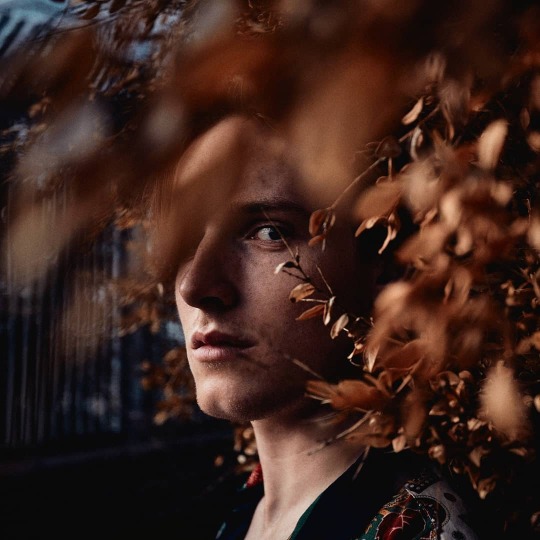
Jonas:
How do you feel about seeing yourself on the screen?
Louis:
That’s OK in principle - I really want to see the work I’ve done. But I can really enjoy a movie as a viewer only if I do not have to rate my own work. Overall, I am very critical of myself and therefore quickly dissatisfied. Sometimes I would wish that I am not so hard on myself, because that would make me more free in the way I work. It hampers you a lot when you’re too scared of failure or too much pressure - you realize, pressure is a big issue in my life.
Jonas:
In a few months, the film "Deutschstunde” will start in the cinemas, for which you have taken on a supporting role. In the film adaptation of the novel by the same name by Siegfried Lenz about an expressionist painter, where a prohibition of the profession was imposed by the Nazis in 1943. This repression existed in Germany not only at the time of National Socialism, but also in the former GDR. In some countries, such as China, even today, professional bans are being imposed. How would you react if you were no longer allowed to be an actor?
Louis:
I have never asked myself this question. It makes perfect sense to consider it. I suspect that I have never dealt with the question because here in Germany we are in a very privileged situation where we are allowed to practice what we want as a profession. If that were forbidden, I would be completely at a loss. Acting is what I do best of all activities and what I like to do most. There never was a plan B in my life either - so I would not know what to do with myself.
Jonas:
Can you “not act” as an actor at all?
Louis:
Of course, in everyday life you can stop it. However, every actor is inclined to be a permanently on game, such as with jokes, gestures or certain behaviors. It is easy to express oneself. I believe that in order to give the truth to a person, one must draw truth from oneself. And if you no longer have truths, you can not play them. On the other hand, I have the experience that I always take parts of my characters into my own life or discover new things about myself through them. In other words: through the role, I open a box, which then remains open a bit. As a result, my roles always change a bit for me as well. For example, I feel like through the many sensitive characters that I was allowed to play, I have embraced the sensitive side in myself more - unfortunately I can not find a word in German with which I could better express that. What I mean by that: Had I not played so many sensitive characters, today I would be a sensitive person, but not to the extent that I have become in the end.

Jonas:
Which of your projects has been the most emotionally charged so far?
Louis:
I would say that was “Prélude” by Sabrina Sarabi, which will be released on August 29th. In the film, I play the young piano student David, who suffers from strong self-doubt and feels a huge pressure of expectation - a situation that I can understand very well, as already mentioned. However, with David, he loses control of his life and threatens to break under the pressure.
This movie is the first one I for which I have prepared with a coach. When working with acting coach Frank Betzelt, it was especially about how the energy between the individual characters felt, what these energies wanted and how they influenced the characters. That helped me a lot to dig deep into my role. For example, I have discovered a much greater access to the feeling of anger, mainly to self-rage. I personally did not know that feeling before. Until then, I have never felt the need to be angry, let alone gain access to this emotion.
All in all, during this time I let David’s emotional world come close to me - and literally took it home with me. That put a strain on me not only during preparation and shooting, but also for almost a whole year afterwards.
Jonas:
How exactly?
Louis:
For example, a few months after filming, there was an incident that happened when I was visiting my parents in Cologne with my girlfriend. After watching a couple of episodes of “Babylon Berlin” with Liv Lisa Fries - Liv plays my girlfriend in “Prélude” - I felt an extreme unease in the next morning. I was kind of aggressive and in a bad mood, which kept increasing throughout the day, until I finally just collapsed in the evening. Probably the situation with my parents at home and with my girlfriend on the side gave me such a safe space that I could process all this again. There was apparently no real opportunity to do that before because after the “Prélude” shoot exciting things kept happening. I had the impression that I had dragged this topic for months and only let everything out during my visit in Cologne. But I did not really get rid of it. When I saw the movie for the first time some time later, I was really sad for two or three days and did not know why. So I called Frank Betzelt, who had coached me then. He just asked me one question: “What really bothers you? The fact that you are so sad or that you do not know why you are sad?”
Jonas:
What a clever question!
Louis:
An incredibly smart question! My answer was, “Because I do not know why this is happening to me.” And then Frank said it was fine and I did not have to fight it. The reason for this is that I have grown so fond of the character and thereby experienced the suffering of this young artist even more intensely. We talked about it for a while - and after that phone call it was OK.

Jonas:
Kat Frankie, a singer-songwriter living here in Berlin, wrote the interesting sentence: “People that write sad songs are a little happier.” Is that similar to actors who play sad roles?
Louis:
You can say that the other way around too - look at Robin Williams, who was hilarious in his roles, but must have been extremely sad in his private life and finally took his own life. Basically, I think that actors who play a lot of melancholic roles, also need a certain fascination. And if you have that fascination in general, you have it when you’re not acting as well.
Jonas:
If you ignore the expectations of other people: What is your own claim to yourself?
Louis:
I have a very high standard of myself and I am extremely ambitious.
Jonas:
That means you’re also prone to criticism?
Louis:
I’m trying not to be that. It’s a bit strange to me anyway: I’m really excited about criticism and sometimes find it strange when there’s none at all - especially when I know for sure that there’s something to criticize. At the same time, it is not so easy for me to handle criticism when it is actually voiced, especially if it comes from myself. I wish that was easier.
Jonas:
Are you someone who takes things from peers?
Louis ( smiles ):
Off or on? No, seriously, I think you have to make sure that you can focus on your own work and not get too confused by the hype that is often justified by some of your colleagues. But I also think it’s just right as an actor to keep your eyes open and to be inspired by what’s being done elsewhere. But we should all be in this world anyway, no matter if actor or not.
14 notes
·
View notes